
|
All conductors evolve throughout their careers – some subtly (Reiner, Monteux, Ansermet), others more palpably yet steadily (Bernstein, Toscanini, Celibidache). Among all the giants of the baton, Bruno Walter (1876 – 1962) was unique, as his interpretive outlook changed more suddenly, more often and more radically than any other.
Far too often Walter's final series of stereo recordings dominates commentaries and eclipses all that preceded them. Thus in Harold Schonberg's The Great Conductors we read: "As an interpreter he represented dignity, nobility, compassion. � [H]is rhythms were smooth-flowing, inevitable-sounding, undistorted by rubato. � He made music lovingly. � There never was a strained moment, never a trace of hysteria" but rather a "relaxed, comforting, � genial, unhurried, fluid approach." Such descriptions are apt, but pertain only to the very close of a long musical life of sweeping change and diverse disposition.
→To avoid confusion or worse, let me be clear at the outset about what this article is – and is not. It does not purport to be a biography, a comprehensive discography or a probing analysis of Walter's recordings or of the underlying works. In the references section below I've suggested other sources for the first two and I'm both disinclined and ill-equipped for the rest. Rather, it's my attempt to trace the evolution of his interpretive art throughout an extraordinary career, with especial emphasis on the phases most commentators gloss over or altogether ignore.
Walter's early career followed the typical arc for conductors raised in late 19th-century European traditions, but with one grand distinction. Nurtured as a child prodigy, he first seemed destined for a calling as a concert pianist, dabbled in composition, was galvanized by a single experience (here, attending an 1888 concert conducted by Hans von Bulow), was enthralled by the revelation of Wagner, rose through the ranks of vocal coach and assistant conductor in increasingly prestigious opera houses, and ultimately was entrusted with orchestral assignments.
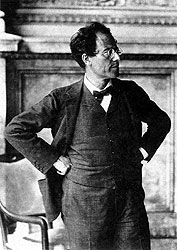 Gustav Mahler |
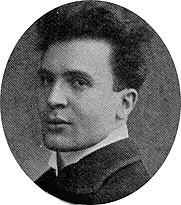 Bruno Walter, 1910 |
Little meaningful guidance as to the first three decades of Walter's work can be gleaned from surviving accounts, which are bafflingly disparate and seemingly irreconcilable. Thus a report of a 1911 Munich Messiah asserted that he concluded the "Hallelujah Chorus" by accelerating to twice the tempo and "earth-shaking volume," while his first visit to the U.S. in 1923 was dismissed as too controlled, dignified and reserved to satisfy the American temperament. Indeed the confusion would hardly abate even when the first-hand evidence of recordings was available – the 1951 Grove's Dictionary offers that he "excels in sensuous music � though never to excess" while the 1948 Dictators of the Baton slams him for "yielding too often to the urge of overinterpretation. He is so carried away by the music that he cannot resist the temptation [of] permitting the full tide of his feelings to overflow � sometimes inserting uncalled for pauses to heighten suspense, utilizing rubato with too lavish a hand, touching lyric pages with saccharine." Clearly, such reviews reflect the authors' outlooks rather than reliable objective analyses. Walter's own writings are too abstract to be helpful – describing Mahler's outlook (and presumably his own aspirations), Walter cited a "need to seek the eternal" and to be "brimming with life" so as to "seek solutions to insoluble problems" and "speak with particular intensity of the secrets of our existence" – what artist doesn't aspire to that?
In a 1956 interview issued on a Columbia promotional LP to honor his 80th birthday (and assigned catalog number BW 80), Walter claimed "a very vivid recollection" of his first recordings: "I think it was an entr'acte from Carmen; three entr'actes from Carmen � in 1900 in Berlin. Yes, I was at the Opera, the Royal Opera conductor � I was at the tender age of 24. I had conducted concerts already and was invited to make records." Yet despite the accuracy of his other memories late in life this one seems wildly improbable, given the absence of even a single copy of any such disc, any corroboration from documentation, nor mention in others' remembrances. Indeed, recordings of orchestras (as opposed to concert bands) were extremely rare at that time, and with good reason, as the acoustic apparatus (in which the cutting stylus was directly driven by sound gathered by a horn) captured the fundamental notes and most overtones of the human voice, piano and most brass and winds, but not the wider range, broader dynamics and more complex timbre of full ensembles.
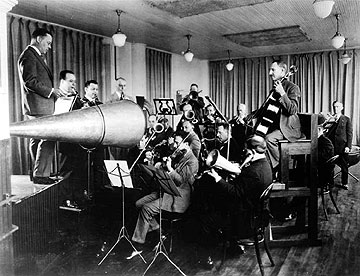 An acoustical recording session |
Although generally slighted, if not outright ignored, in most surveys of Walter's career, his acoustical recordings are significant as the earliest tangible evidence of his art. (Indeed, a recent Warner Classics Icon CD box entitled Bruno Walter – The Early Years begins only in the mid-1930s.) Coming as he approached the mid-point of his career as a conductor, they provide a window, albeit a hazy one, to directly glimpse his style that already had enthralled audiences for his first 30 years on the podium, and to bypass reliance on confusing written accounts. Yet they are far from perfect messengers. Even beyond its inherent and unavoidable technical limitations, the acoustic recording process severely challenged conductors (and, for that matter, any musician) who found himself in an alien and forbidding setting. In lieu of a full complement of musicians, the ambience of concert halls to which he was accustomed in shaping a sonic image and an audience whose response was a necessary source of inspiration, he could only use a drastically-reduced number of players crammed into a stiflingly small room to concentrate the sound. He further had to temper dynamic shadings so as to boost quiet passages above the considerable noise floor and avoid loud climaxes that caused distortion, substitute flatulent tubas and bassoons for string basses (and often cellos as well) which recorded as a sonic blur, chop extended works into segments to fit the maximum side length of a few minutes while trying to preserve a sense of continuity and, in the absence of any means of editing, accept technical flaws or execution glitches to avoid having to redo an entire side (which often required reconvening a wholly new session, as there was no means of instant playback to discover lapses before test pressings were made). Under such circumstances, it seems amazing that even a trace of inspiration could emerge. And yet, despite these severe compromises, Walter's acoustical sides present an enticing opportunity to infer the missing first half of his career beyond the vague and often meaningless descriptions of reviews and memoirs.
Walter's first August 1923 sessions began with the simple 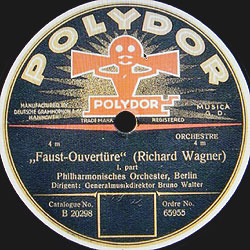
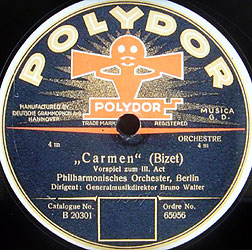 Act III Intermezzo and Act IV Prelude of Carmen (so at least his memory of the repertoire was correct) and four overtures – Wagner's Faust, Beethoven's Coriolan, Mendelssohn's Hebrides and Berlioz's Roman Carnival, all in thoroughly credible readings. Heard in order of the matrix numbers, Walter's confidence seems to grow, beginning in the Carmens with cautious pacing and with the melodic line often submerged – understandable for his first venture, although the orchestras, the Berlin Philharmonic and Berlin Staatskapelle (State Opera Orchestra), had ample studio experience. As the sessions progressed he applied increasingly varied tempos and procured more spirited playing. By the time of his next January 1, 1924 session of overtures with the same ensemble more personality emerges – a delightful and propulsive Berlioz Benvenuto Cellini and, remarkably, a rarity: Cherubini's Der Wassertr�ger, a refreshing break from the warhorses to which recorded repertoire generally adhered at the time, albeit a rather uninspired work and launched here with some painful string intonation. A final set of overtures for Polydor was cut on March 1, 1925 – a buoyant Mozart Cosi fan tutti, a finely-shaded Idomeneo and a sizzling Schumann Manfred (although it's tempting to attribute its driven pace less to an interpretive choice than a necessity to have fit all 10� minutes – compared to a normal 12 or so – onto two 12" sides).
Act III Intermezzo and Act IV Prelude of Carmen (so at least his memory of the repertoire was correct) and four overtures – Wagner's Faust, Beethoven's Coriolan, Mendelssohn's Hebrides and Berlioz's Roman Carnival, all in thoroughly credible readings. Heard in order of the matrix numbers, Walter's confidence seems to grow, beginning in the Carmens with cautious pacing and with the melodic line often submerged – understandable for his first venture, although the orchestras, the Berlin Philharmonic and Berlin Staatskapelle (State Opera Orchestra), had ample studio experience. As the sessions progressed he applied increasingly varied tempos and procured more spirited playing. By the time of his next January 1, 1924 session of overtures with the same ensemble more personality emerges – a delightful and propulsive Berlioz Benvenuto Cellini and, remarkably, a rarity: Cherubini's Der Wassertr�ger, a refreshing break from the warhorses to which recorded repertoire generally adhered at the time, albeit a rather uninspired work and launched here with some painful string intonation. A final set of overtures for Polydor was cut on March 1, 1925 – a buoyant Mozart Cosi fan tutti, a finely-shaded Idomeneo and a sizzling Schumann Manfred (although it's tempting to attribute its driven pace less to an interpretive choice than a necessity to have fit all 10� minutes – compared to a normal 12 or so – onto two 12" sides).
In the meantime, in May 1924 Walter cut seven sides in London for Columbia with the Royal Philharmonic Orchestra (a complete Wagner Siegfried Idyll and part of Strauss's Tod und Verkl�rung) but all were rejected. He returned in December for both works, this time successfully. The Strauss seemed a curious choice for acoustical recording, which tended to fuse complex textures of climaxes into a shrill sonic smudge, while lighter scoring, softer passages and sustained notes blended better and emerged considerably more intact. Walter's reading summons rhythmically-precise playing and achieves a keen evolution from the atmospheric opening (abetted by prominent expectant tympani taps) through explosive friction and soothing resolution, and even manages to clarify the climactic strands rather successfully through judicious balances. Comparison with contemporaneous recordings can be instructive. A 1923 HMV recording by Albert Coates and the London Symphony is more richly recorded but reflects a similar interpretive outlook from a conductor known for communicating ardent urgency, whiplash tempos and an overall improvisatory feel. In later life Hermann Abendroth would display comparable personality but his 1922 Polydor set with a "Philharmonisches Orchester" (possibly the Berlin Philharmonic shrewdly hiding its identity behind some excruciatingly crude execution) is far broader (24 minutes vs. Walter's 21) and rather dispassionate, although the final massive climax is effectively wrought. 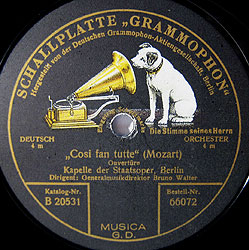 A further inevitable juxtaposition is with the composer's own 1926 electrical recording with the Staatskapelle, effective in its own right while progressing somewhat more objectively, as expected from a conductor whose restraint was often mistaken for indifference or worse. Alongside these others, Walter's early venture acquits itself quite well.
A further inevitable juxtaposition is with the composer's own 1926 electrical recording with the Staatskapelle, effective in its own right while progressing somewhat more objectively, as expected from a conductor whose restraint was often mistaken for indifference or worse. Alongside these others, Walter's early venture acquits itself quite well.
Walter's Siegfried Idyll is a full-bodied account, ranging from a tender Viennese lilt with tasteful portamento (sliding between string notes) to strong ardent outbursts, although the resonances of the acoustic horn lend strange voicings to some of the chords. For comparison, authentic Wagnerian style of the time can perhaps be gleaned from two early electrical recordings. The composer's son Siegfried could claim a unique connection to the Idyll, as his birth provided the occasion for Wagner to write and first perform it as a combined birthday and Christmas present for his wife. But while never known as a great conductor, Siegfried had a strong pedigree beyond genetics, as he was entrusted with a dozen complete Ring cycles at Bayreuth, the last in 1928. His 1927 HMV recording of "his" Idyll with the London Symphony is far more temperate than Walter's, with a steadier and considerably faster pace. Also apt is a 1929 Electrola Idyll by the Staatskapelle under Karl Muck, a celebrated Wagnerian with a 30-year tenure at Bayreuth (which was interrupted by an unfortunately brief wartime appointment to lead the Boston Symphony – after refusing to precede one concert with the "Star Spangled Banner" he was branded a spy and deported). Although closer to Walter's relaxed tempo, Muck's Idyll, like Siegfried's, is emotionally tepid with little of Walter's plastic shaping of the phrasing.
Walter's most substantial acoustical venture was a Tchaikovsky Symphony # 6 ("Path�tique"), recorded for Polydor in Berlin with the Staatskapelle on March 1, 1925. 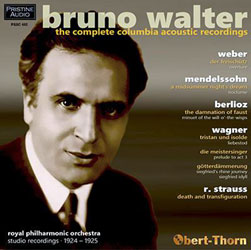 Walter's waxing of all ten sides – plus five more for the Mozart and Schumann overtures – in quick sucession testifies to his growing poise in the studio, a confidence further reflected in the maturity of the result, boasting moderated moods, with elastic tempos and smooth integration of the variegated musical impressions. There had been three prior acoustic versions, all from 1923, and they provide a useful comparison. The Staatskapelle under Frieder Weissmann (Odeon) is spread across 12 sides despite a minor trim in the march. Exemplifying his reputation as a reliable (i.e., safe) conductor, Weissmann takes no interpretive risks but rather is weighty, slow and seething, lending the work a consistently tragic aura, opting to drain the waltz of most of its inherent grace and the march of its excitement in favor of a pervasive fatalism. In marked contrast, Henry Wood and the New Queen's Hall Orchestra (Columbia), with heavily-abridged first and second movements, is mostly propulsive and brisk, taming emotional peaks and affording little opportunity for reflection or repose, setting up an effective contrast with an emphatic, dark-toned, brass-heavy finale. Ronald and the Royal Albert Hall Orchestra (HMV) take a more mainstream approach, varying the tempos considerably to reflect the impact of each section. Perhaps owing to his vast studio experience, with the exception of a few untamed brass outbursts in the march, balances are precise, with melodic lines confidently striding atop accompaniment that remains fully audible in its own right. (Walter's Path�tique was its first complete recording, although Ronald's, waxed and issued over a year earlier, came quite close, with only a few trifling excisions in the first and last movements.) A further fascinating account came from Coates and the London Symphony Orchestra (HMV, 1926) with a huge range of tempos that accelerate dramatically for climaxes and decelerate for repose, coupled with dynamic emphases that fully underline the emotional content. Compared to these, Walter occupies a middle, eminently musical ground, embracing the full emotional content of the Path�tique, but without opting for one interpretive extreme to the exclusion of others. Phrases are carefully shaped, the waltz has a distinctive Viennese lilt, the march builds to a thrilling summit and the finale heaves with passion, all achieved with smooth transitions and continuity, in an exemplification of the romantic ideal of not breaking the musical line. Overall, aside from the sound itself, it's a remarkable achievement.
Walter's waxing of all ten sides – plus five more for the Mozart and Schumann overtures – in quick sucession testifies to his growing poise in the studio, a confidence further reflected in the maturity of the result, boasting moderated moods, with elastic tempos and smooth integration of the variegated musical impressions. There had been three prior acoustic versions, all from 1923, and they provide a useful comparison. The Staatskapelle under Frieder Weissmann (Odeon) is spread across 12 sides despite a minor trim in the march. Exemplifying his reputation as a reliable (i.e., safe) conductor, Weissmann takes no interpretive risks but rather is weighty, slow and seething, lending the work a consistently tragic aura, opting to drain the waltz of most of its inherent grace and the march of its excitement in favor of a pervasive fatalism. In marked contrast, Henry Wood and the New Queen's Hall Orchestra (Columbia), with heavily-abridged first and second movements, is mostly propulsive and brisk, taming emotional peaks and affording little opportunity for reflection or repose, setting up an effective contrast with an emphatic, dark-toned, brass-heavy finale. Ronald and the Royal Albert Hall Orchestra (HMV) take a more mainstream approach, varying the tempos considerably to reflect the impact of each section. Perhaps owing to his vast studio experience, with the exception of a few untamed brass outbursts in the march, balances are precise, with melodic lines confidently striding atop accompaniment that remains fully audible in its own right. (Walter's Path�tique was its first complete recording, although Ronald's, waxed and issued over a year earlier, came quite close, with only a few trifling excisions in the first and last movements.) A further fascinating account came from Coates and the London Symphony Orchestra (HMV, 1926) with a huge range of tempos that accelerate dramatically for climaxes and decelerate for repose, coupled with dynamic emphases that fully underline the emotional content. Compared to these, Walter occupies a middle, eminently musical ground, embracing the full emotional content of the Path�tique, but without opting for one interpretive extreme to the exclusion of others. Phrases are carefully shaped, the waltz has a distinctive Viennese lilt, the march builds to a thrilling summit and the finale heaves with passion, all achieved with smooth transitions and continuity, in an exemplification of the romantic ideal of not breaking the musical line. Overall, aside from the sound itself, it's a remarkable achievement.
At the time Walter praised his acoustic recordings (admittedly in a promotional statement) as having made him "greatly pleased. � What sonic beauty in the voices, what pure reproduction and instrumental subtleties, what clarity and fullness in the recording of the orchestral performance." Although he later would dismiss them as "a mechanical device emitting ugly imitative musical noise," his first recordings transcend the constraints of the mechanism to suggest a winning blend of vitality and reflection that would contend for dominance throughout the rest of his career.
[A word about transfers – I truly envy collectors having precious (and often severely worn) original 78s, but the rest of us necessarily must rely on vinyl and now digital transfers of their materials, which range from straightforward copying to running a gantlet of computer programs to attenuate the considerable surface noise, tame resonances, evade scratches, smooth speed instability and extract all available sonic information (but without falsifying it by generating bass and overtones absent from the sources). Taking a proactive approach, Pristine Audio has issued all the Walter acoustics and they sound splendid – hardly hi-fi, but far better than any reproducing instrument of the time could muster. Purists may (and do) quibble over concerns with authenticity, but the result helps to narrow the audible gap between these ancient carriers and their successors, and to better display the unique interpretive possibilities they preserve.]
1925 brought the electrical recording process which vastly enhanced sonic fidelity through sensitive microphones,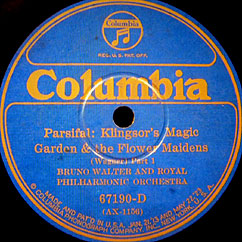 the ability to mix multiple inputs to adjust balances and a wider frequency range that included genuine bass and higher harmonics. Although the continued use of 78 rpm shellac discs still limited playing time to five minutes per side, full orchestras with all prescribed instruments now could be arrayed normally in resonant halls to emulate a concert experience. But with progress came an unavoidable snag: the rich legacy of an entire generation of acoustical recordings was relegated to obscurity.
the ability to mix multiple inputs to adjust balances and a wider frequency range that included genuine bass and higher harmonics. Although the continued use of 78 rpm shellac discs still limited playing time to five minutes per side, full orchestras with all prescribed instruments now could be arrayed normally in resonant halls to emulate a concert experience. But with progress came an unavoidable snag: the rich legacy of an entire generation of acoustical recordings was relegated to obscurity.
Walter's first electrical sessions in November 1925 focused on excerpts from Parsifal with the Royal Philharmonic Orchestra. The first, "Klingor's Magic Garden and the Flower Maidens," boasts rich (if a bit overripe) bass, distinctive timbres and a full dynamic span, led by Walter with assurance and suppleness – and a remarkable degree of continuity despite having to be recorded on four discrete wax masters. (Any disjointedness between sides never would have been noticed at the time, as it would have vanished during the 10+ seconds required to change discs on the manual turntables of the era.)
Along with more overtures and chunks of Wagner, Walter's studio work soon ventured into more substantial repertoire. In November 1926 he cut a complete Beethoven Fifth with the Royal Philharmonic but it was never issued. So instead, his first published symphony performance was the Schumann Fourth recorded in July 1928 with the so-called Mozart Festival (actually the famed Paris Conservatory) Orchestra in which his smooth-flowing interplay of volatile energy and classical order seems to exemplify the very essence of Romanticism. (His 1938 remake with the Vienna Philharmonic, also for HMV, is far more mellow with moderated tempos and lacks the thrilling surges of insistent passion – as well as the finale repeat – of the earlier version.) At the end of his life Walter reportedly was planning a set of all four Schumann symphonies, but we only have one other – an austere, prosaic 1941 NY Philharmonic Third (Columbia) with a downright somnolent Scherzo.
Mozart ~ Walter devoted much of what would become his final decade in Europe to documenting his cherished Viennese composers, beginning with Mozart.
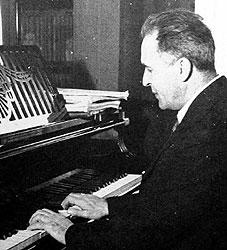 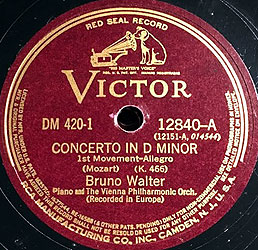 A rarity – Walter at the keyboard |
Haydn ~ Of the six Haydn symphonies he ultimately would record, Walter cut four in 1937-1938 for Victor. Ironically, they reverse the trend with his Mozart, displaying far more style with British and French orchestras than with the Vienna Philharmonic. Most depressing is # 100 with a stodgy Allegro and no "Turkish" percussion battery nor any other hint of drama to enliven the Allegretto (and thus robbing the work of the essence conveyed by its very nickname – the "Military"). The other Vienna symphony, # 96, seems too suave and patient to deliver Haydn's trademark wit and vivacity. In contrast, # 92 (with the Paris Conservatory) is animated with a rip-roaring finale and # 86 (London Symphony) bursts with athletic vitality, both possibly reflecting Walter's relief from having recently escaped the Anschluss to more welcoming countries.
Beethoven ~ With the 1926 Fifth unreleased,
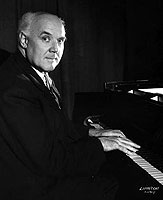 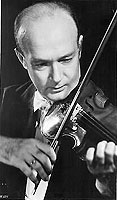 Walter Gieseking and Joseph Szigeti |
1936 brought Walter's only pre-war Beethoven symphony recording – an HMV "Pastoral" with the Vienna Philharmonic. By then, even aside from two complete acousticals led by Hans Pfitzner (1923, Polydor – mostly relaxed and lovely) and Frieder Weissmann (1924, Parlophone – bursting with enthusiasm and character), collectors had a choice of at least six competing versions in a wide range of interpretations – Felix Weingartner/Royal Philharmonic (1927, Columbia – quickly-paced); Franz Schalk/Vienna Philharmonic (1928, HMV – simplified steady tempos but subtle shifts to underline the "Scene By the Brook"); Serge Koussevitzky/Boston Symphony (1928, Victor – patrician refinement); Max von Schillings/Staatskapelle (1929, Parlophone – relaxed but heavily inflected); Pfitzner (a first remake)/Staatskapelle (1930, Polydor – contemplative and pliant); and Paul Paray/Colonne Orchestra (1934, Columbia – extremely swift). 1937 would bring two more – Toscanini/BBC (EMI – fundamentally propulsive but with enough elasticity to avoid a sense of mechanical rigidity) and Willem Mengelberg/Concertgebouw (Telefunken – bursting with deeply personal and fascinating emphases, balances, ornaments, dynamics and phrasing). 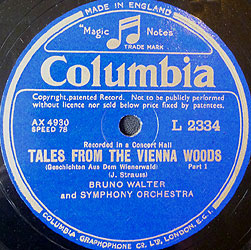
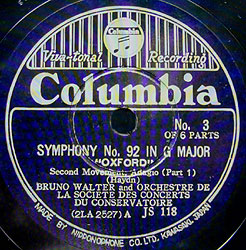 Amid this bounty, Walter's account acquits itself quite well – refined, plush, secure and exuding a warmth and sincerity that echoes the composer's feelings in conveying the wonders of his beloved nature, and noticeably slower recapitulations as though to invoke the heartfelt ease of an idealized ingenuous peasant life of rustic dances and heartfelt thanksgiving – and yet, atypically for him, Walter summons a potent thunderstorm with pounding tympani and slashing strings.
Amid this bounty, Walter's account acquits itself quite well – refined, plush, secure and exuding a warmth and sincerity that echoes the composer's feelings in conveying the wonders of his beloved nature, and noticeably slower recapitulations as though to invoke the heartfelt ease of an idealized ingenuous peasant life of rustic dances and heartfelt thanksgiving – and yet, atypically for him, Walter summons a potent thunderstorm with pounding tympani and slashing strings.
Strauss ~ It might seem reasonable to assume that a collegial conductor's results would largely depend upon the character of the orchestras he led. Walter's first recordings of Strauss – Johann Jr., not Richard – invite a fascinating test of that theory. Results from the same orchestra turned out quite differently – twice. A January 1929 session with the Staatskapelle produced two widely disparate outcomes – a crisp, energetic Fledermaus Overture with well-defined sections along with a tender Wiener Blut waltz with exquisitely delicate string portamento (sliding between notes). Similar inconsistency arose in an April 1929 session with an unnamed British orchestra (possibly the London Philharmonic?) – Tales From the Vienna Woods is graced with elegance while the Gypsy Baron Overture is bland and impersonal. Nor did orchestras always yield outcomes predicted by their reputations – while a 1930 Berlin Philharmonic Roses From the South is expectedly thick and earth-bound, in a 1937 Vienna Philharmonic Emperor Waltz we hear little of the effortless, irrepressible rhythmic vitality that so many others induced from that ensemble in Strauss – not just Viennese natives like Kleiber and Krauss, but outsiders like Szell, Knappertsbusch and even Furtw�ngler.
Brahms ~ As for another pillar of Viennese Romanticism, Walter cut three of the four Brahms symphonies during this era, all for HMV/Victor, beginning with a 1934 Fourth with the BBC Symphony. As with the "Pastoral", he entered an already populated field but here faced a more daunting challenge – a recording by a conductor who knew the composer and left a compelling account from which to infer Brahms's own taste – although Max Fiedler (1859 – 1939) only took up conducting after Brahms died, the composer admired his piano playing and they became close friends. Fiedler's 1930 HMV recording with the Berlin State Opera Orchestra is impulsive and mystical, constantly alive with emphatic phrasing, tempo extremes and bold expressive touches that announce a partnership between composer and interpreter and a deeply personal journey to find passion and inject a sense of instability beneath the objective surface of the score. 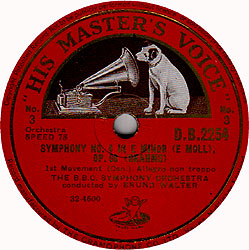
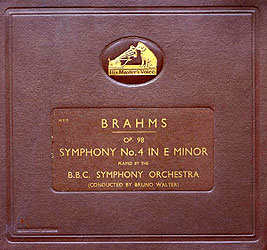 Yet in marked contrast, a 1938 EMI recording with the London Symphony by Felix Weingartner (1863 - 1942), the only other conductor on record who had worked with Brahms, is fundamentally steadfast, restrained, subtly inflected, elegant and shorn of rhetoric, but its authenticity can be discounted, as his approach had fully evolved during the intervening half-century from his deeply personal proactive manner of the late 1800s (Walter branded him as having a "fiery temperament") to his pioneering of the modern objective style that came to dominate the 20th century. Even so, Walter seems to bridge the interpretive gap between the Fiedler and Weingartner recordings – the first two movements begin gently and relaxed but pick up vast speed and energy as they unfold, the third zips by nearly a minute faster than Toscanini's and, in a herald of Furtw�ngler's astounding concert readings, the finale wallows in German weight before a rip-snorting wrap-up. Although balances in the softer sections tend to obscure the melodic lines, Walter's sensitive phrasing is wondrous throughout. The BBC orchestra was only four years old at the time, and thus perhaps more amenable to bold leadership than the century-old, self-governing and chauvinistic Vienna Philharmonic, with which Walter recorded the Third in 1937 and the First in 1938. Both glow with the famed orchestra's burnished sound and the finales spring to life, but elsewhere the leadership tends to sound more dutiful than inspired.
Yet in marked contrast, a 1938 EMI recording with the London Symphony by Felix Weingartner (1863 - 1942), the only other conductor on record who had worked with Brahms, is fundamentally steadfast, restrained, subtly inflected, elegant and shorn of rhetoric, but its authenticity can be discounted, as his approach had fully evolved during the intervening half-century from his deeply personal proactive manner of the late 1800s (Walter branded him as having a "fiery temperament") to his pioneering of the modern objective style that came to dominate the 20th century. Even so, Walter seems to bridge the interpretive gap between the Fiedler and Weingartner recordings – the first two movements begin gently and relaxed but pick up vast speed and energy as they unfold, the third zips by nearly a minute faster than Toscanini's and, in a herald of Furtw�ngler's astounding concert readings, the finale wallows in German weight before a rip-snorting wrap-up. Although balances in the softer sections tend to obscure the melodic lines, Walter's sensitive phrasing is wondrous throughout. The BBC orchestra was only four years old at the time, and thus perhaps more amenable to bold leadership than the century-old, self-governing and chauvinistic Vienna Philharmonic, with which Walter recorded the Third in 1937 and the First in 1938. Both glow with the famed orchestra's burnished sound and the finales spring to life, but elsewhere the leadership tends to sound more dutiful than inspired.
Schubert ~ For the most Viennese Romantic composer (the only one born and raised there) Walter bestowed one of his finest recordings with its resident orchestra – a Schubert "Unfinished" Symphony (Vienna Philharmonic, 1936, HMV) of total commitment and immersion, ideally balanced between tension and ease, turmoil and serenity, resolute headway and brooding thoughts, all integrated with a magical organic flow and natural breath, in one of its finest performances on record. By comparison, Walter's "Great" Symphony # 9 with the London Philharmonic (1938, HMV) barely lives up to its name, sounding rather unfocused and largely devoid of weight, much less charm or nuance. (Curiously, a filler of the Rosamunde G-Major ballet music cut at the same session, although admittedly posing far fewer interpretive challenges, is considerably more delicate and vivacious, while a companion Rosamunde E-minor ballet is nearly as mundane as the "Great.")
Politically na�ve, Walter might not have realized it at the time, but he closed the first, longest and deepest-rooted phase of his career with three superlative recordings with the Vienna Philharmonic that would serve not only as touchstones of his art up to that point but as souvenirs of the Europe in which he was nurtured and lionized, and to which he would return years later, but only as an occasional guest.
Wagner: Die Walk�re – Act I – Lauritz Melchior, Lotte Lehmann, Emanuel List (June 20-22, 1935, HMV) – For most of his professional life Walter was best known as a conductor of opera. Yet while he recorded overtures, instrumental interludes and a few aria accompaniments he never led a complete opera in the studio.
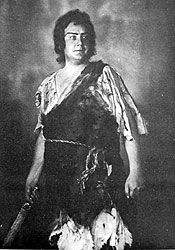 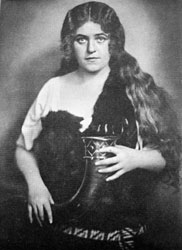 Lauritz Melchior and Lotte Lehmann |
Mahler: Das Lied von der Erde – Kerstin Thorborg, Charles Kullman, Vienna Philharmonic (May 24, 1936, Columbia) – Equally remarkable yet even more meaningful was this very first recording of Mahler's penultimate work. Having not only trained under Mahler but becoming his closest professional colleague and acolyte, Walter was entrusted with the score of Das Lied von der Erde and led its posthumous world premiere. 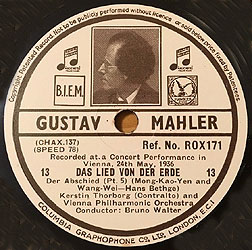 A quarter-century later, Mahler was still remembered as an influential conductor but barely recalled as a composer. Das Lied apparently was deemed too obscure to risk the expense of studio sessions or commercial release, and so its 14 sides were cut live at a concert by the newly-formed Mahler Society to commemorate the 25th anniversary of the composer's death and sold on a subscription basis. Despite inevitable blemishes, the result is an intensely human document, propelled by a marvelous feeling of spontaneity that eludes all subsequent recordings (including Walter's own two). Orchestra and vocalists dig into their notes with wholehearted abandon, often taking substantial liberty with the prescribed rhythm. Both singers project vast sincerity and even vulnerability by holding their vibrato to a minimum, and in the process avoid any suggestion of stylized opera or refined art singing. While the somewhat crude sound obscures some of the detail and weakens the delicacy of the ethereal ending, the instrumental choirs compensate by standing out with vivid detail that highlights the inventiveness of Mahler's scoring. Although relatively fleet, Walter's pacing never seems rushed, but rather vibrant and lucid. As Walter wrote at the time, he tried to create a first-time experience: "The supreme value of Mahler's work lies not in the novelty of it being intriguing, daring, adventurous or bizarre but rather in the fact that this novelty was transfused into music that is beautiful, inspired and profound."
A quarter-century later, Mahler was still remembered as an influential conductor but barely recalled as a composer. Das Lied apparently was deemed too obscure to risk the expense of studio sessions or commercial release, and so its 14 sides were cut live at a concert by the newly-formed Mahler Society to commemorate the 25th anniversary of the composer's death and sold on a subscription basis. Despite inevitable blemishes, the result is an intensely human document, propelled by a marvelous feeling of spontaneity that eludes all subsequent recordings (including Walter's own two). Orchestra and vocalists dig into their notes with wholehearted abandon, often taking substantial liberty with the prescribed rhythm. Both singers project vast sincerity and even vulnerability by holding their vibrato to a minimum, and in the process avoid any suggestion of stylized opera or refined art singing. While the somewhat crude sound obscures some of the detail and weakens the delicacy of the ethereal ending, the instrumental choirs compensate by standing out with vivid detail that highlights the inventiveness of Mahler's scoring. Although relatively fleet, Walter's pacing never seems rushed, but rather vibrant and lucid. As Walter wrote at the time, he tried to create a first-time experience: "The supreme value of Mahler's work lies not in the novelty of it being intriguing, daring, adventurous or bizarre but rather in the fact that this novelty was transfused into music that is beautiful, inspired and profound."
While Walter undoubtedly had matured and evolved over the quarter-century that had elapsed since he explored the work with its composer, this first recording, even aside from its intrinsic splendor, boasts unique authenticity. Mahler had written to Walter: "I know of no one who understands me as well as I feel you do and I believe I have entered deep into the mine of your soul." Mahler's widow Alma also credited Walter with a full understanding of her husband and wrote: "After [Mahler's] death, Walter's great and exalted art was at his service. He mastered its every subtlety � and he took the spirit of Mahler's work as the keystone of his own work as an interpretive musician." Mahler's own conducting reportedly was full of tension, poised uneasily between precision and clarity vs. passion and spontaneity. Walter recalled it as both tyrannical intimidation and passionate stimulation. Mahler never cut any records but did make four piano rolls in 1905 in the Welte-Mignon process that captured not only the notes but their nuance and provides an uncannily accurate reproduction of the quality of the original playing. Yet his rolls are full of quirky tempos and largely disregard the many detailed expressive and dynamic felicities specified in the scores. Perhaps the rolls were an anomaly – Mahler never was deemed a virtuoso pianist and may have been unnerved by his first (and only) exposure to the demands of the unfamiliar machinery. (Although after the playback Mahler wrote in the studio guest book: "In astonishment and admiration," his reference may have been to the marvels of the technology rather than to the artistic value of the result.) 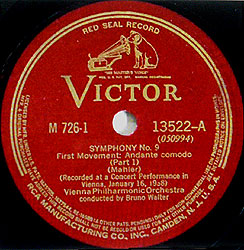
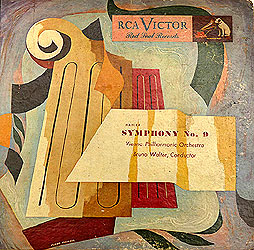 While we never will know how Mahler would have led Das Lied, Walter's 1936 concert seems to exemplify reminiscences of the composer's own outlook. At the same time, it is our earliest document of Walter's radiance in leading live performances, not always captured by his studio work.
While we never will know how Mahler would have led Das Lied, Walter's 1936 concert seems to exemplify reminiscences of the composer's own outlook. At the same time, it is our earliest document of Walter's radiance in leading live performances, not always captured by his studio work.
Mahler: Symphony # 9 (Vienna Philharmonic, January 16, 1938, HMV) – So, too, with Mahler's last completed work, which also had been given its posthumous world premiere by Walter, who recorded it for the first time in concert (along with the Adagietto of Mahler's Fifth Symphony which avoids wallowing in the sentimental glop of so many other readings). At the risk of waxing a bit too poetic, I cannot hope to better Andr� Tubeuf's magnificently moving tribute and historical perspective: "It was final testimony of that sensitive splendor of sound, emotional and noble at the same time, and of that sovereign freedom of rhythm which, as an improvisation, all the great exiles had had as long as the soil of Europe was beneath their feet and the sky of liberty above their head and which they would no longer attain. � We hear a whole world that is on the march, storms which are awakening or dying down, the terrible poetry of evolution, objective and indifferent to Man. � It is this message that Mahler entrusted to his music and Walter received from him and passed on to the orchestra that was the rightful heir to it and had been chosen from amongst all others for this mission. Thus both Mahler and Walter were able to travel to the end of the road." Not only was the Ninth Mahler's farewell to the world, but this particular Ninth served as Walter's own farewell – his last concert before the Nazi invasion ripped him from his native soil. It preserves for one final time a world of music that was about to vanish.
Mozart operas – Fortunately, we have two whole Mozart operas from Walter's last season at the Salzburg Festival – an August 19, 1937 Marriage of Figaro with Ezio Pinza (Figaro), Mariano Stabile (Count Almaviva), Aulikki Rautawaara (Countess Almaviva), Esther R�thy (Susanna) and Jarmila Novotn� (Cherubino) and an August 2, 1937 Don Giovanni with Pinza in the title role and Elisabeth Rethberg (Donna Anna), Luise Helletsgruber (Donna Elvira), Margit Bokor (Zerlina) and Dino Borgioli (Don Ottavio). Both were preserved with the short-lived Selenophone system which exposed an optical soundtrack on 8mm film that enabled continuous takes but posed problems with pitch stability, volume levels and a nitrate base that was both highly flammable and subject to severe deterioration. 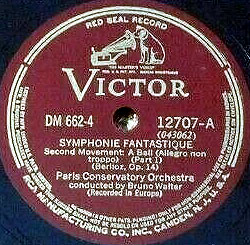 As summarized by Andreas Kluge, Walter credited Mahler with transcending the rococo image of Mozart of daintiness and academic dryness to reveal dramatic sincerity and a wealth of characterization, uncovering layers of compelling truth behind a screen of charm. Consequently, Walter sought an ideal balance of dramatic expression without impairing its musical splendor. I'll gladly leave evaluation of the singing to true opera buffs but, as for Walter, John Quinn on Musicweb calls the Figaro energized: "The recitatives fairly fizz and the pacing of the arias and ensembles is always convincing. This is really involving, dramatic conducting by a true man of the theatre. � Just occasionally some listeners may feel that the performance is just a bit too driven in the heat of the moment and that a little more relaxation might have been welcome. For myself I can only say that I found myself swept along by the thrust and conviction of the whole thing." Much the same can be said for Walter's Giovanni, which explores the darker side of human foibles.
As summarized by Andreas Kluge, Walter credited Mahler with transcending the rococo image of Mozart of daintiness and academic dryness to reveal dramatic sincerity and a wealth of characterization, uncovering layers of compelling truth behind a screen of charm. Consequently, Walter sought an ideal balance of dramatic expression without impairing its musical splendor. I'll gladly leave evaluation of the singing to true opera buffs but, as for Walter, John Quinn on Musicweb calls the Figaro energized: "The recitatives fairly fizz and the pacing of the arias and ensembles is always convincing. This is really involving, dramatic conducting by a true man of the theatre. � Just occasionally some listeners may feel that the performance is just a bit too driven in the heat of the moment and that a little more relaxation might have been welcome. For myself I can only say that I found myself swept along by the thrust and conviction of the whole thing." Much the same can be said for Walter's Giovanni, which explores the darker side of human foibles.
And ... Banned from Germany and no longer welcome in Austria (and to underline the message, his daughter was arrested and detained there), Walter was offered and accepted citizenship by France, where in May 1938 he recorded with the Paris Conservatory Orchestra a rather heavy-handed Handel Concerto Grosso, the Haydn Symphony # 92 and remakes of the Freischutz and Fledermaus Overtures. The following May came a far more interesting Berlioz Symphonie Fantastique. Interpretively, it opts for a middle ground amid the classicism of Weingartner/London Symphony (Columbia, 1925), the near hysterical melodrama of Meyrowitz/Paris Symphony (Columbia, 1934) and the casual "French" sound of Piern�/Colonne Orchestra (Od�on, 1928), but its greater value lies in its exploitation of extremely soft dynamics and the orchestral timbres that, according to Walter, Mahler so admired in Berlioz, as well as its use for the Dies Irae dirge of the deep c-c-G bells that Berlioz preferred in the finale to produce a darkly dissonant and chilling atmospheric impact rather than the terse gongs commonly found in orchestral arsenals and used in nearly every other recording. Marsh asserts that Walter remained fond of this recording as a moral example of resisting others' temptation to treat it as a display piece.
One further artifact from this era is a blend of geography and culture: a Mozart Requiem recorded live on June 29, 1937 at the Th��tre des Champs-Elys�es in Paris but with Austrian performing forces – the Vienna Opera Chorus and Vienna Philharmonic.
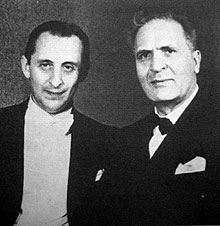 Horowitz and Walter |
Between losing his German homeland and his Austrian substitute Walter concertized throughout free Europe. One the very few documents of a Walter pre-war concert apart from the Vienna Philharmonic is an extraordinary February 20, 1936 broadcast of the Brahms Piano Concerto # 1 in d minor with Vladimir Horowitz and the Amsterdam Concertgebouw Orchestra. Horowitz had first played the Brahms with Toscanini and the New York Philharmonic a year earlier; an extant recording clocks in at a mere 39� minutes (compared to an average 48 or so), is brutally hard-driven and the solos sound rigid and perfunctory. Walter's concert is nearly as swift in its timing but within the same fundamental propulsive approach boasts vastly greater breadth and respite. Of course, it's unfair to generalize from the evidence of a single recording outside the confines of the studio and away from the lustrous sound of the Vienna Philharmonic, and especially when accompanying (and perhaps accommodating) a soloist of headstrong brilliance with an orchestra accustomed to the bold personality of Willem Mengelberg, its permanent conductor. (Walter's only other pre-war Concertgebouw concert recording of which I'm aware is a February 2, 1937 Ravel Concerto in D in which he provides dark, forceful support for (while deferring to the prerogatives of) Paul Wittgenstein, the pianist for whom it was written.) Even so, in retrospect the sheer visceral excitement of the Brahms clearly pointed toward the next phase of Walter's extraordinary career when he would depart so radically from all that had come before.
Walter had first visited the U.S. in 1922 and had been "enraptured from the first moment" he saw California, "captivated by the climate, the light, the colors and the landscape" as well as the mixture of beauty and artifice in Hollywood. After losing his third European home upon the annexation of France, he joined a huge wave of European exiles who combined their brilliant artistic backgrounds with fresh opportunities to establish a colony of musical excellence in Los Angeles.
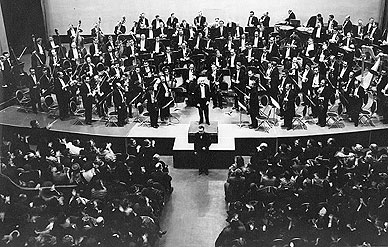 Toscanini and "his" NBC Symphony Orchestra |
The broadcasts were transcribed on 16" 33 1/3 rpm discs using the then-standard 78 groove width rather than the microgroove technology later adopted for commercial LPs. While RCA Victor officially released some of the Toscanini items, all of Walter's remain cached in archives. Through a combination of off-air home recordings and less legitimate means several individual works found their way onto pirate LPs and CDs. Collectors now have assembled all ten complete concerts which afford us an extraordinary opportunity to assess this key phase of Walter's career in its entirety, including several major works absent from his studio output. (And no, I don't feel even the slightest twinge of guilt over the liberation of such fabulous cultural treasures when the legal keepers refuse to make our musical heritage available for scholarship, research or just sheer enjoyment.)
Walter saw his NBC broadcasts as "not an escape from world affairs but an active way to oppose tyranny with a message of hope and promise to all mankind." Of the 35 works he programmed, ranging from pleasant diversions (Mozart Minuets and German Dances) to the monumental (14 symphonies), only a few disappoint – a plodding, rigid Berlioz R�k�czy March and a Ravel Rhapsodie espagnol that generates little sensuality, color or atmosphere. Two others are similar to his prior recordings – a Schumann Fourth with identical timings and only slightly more oomph than his 1938 London Symphony recording, and a Berlioz Symphonie Fantastique (with those same deep bells) that seems less energetic overall than his 1939 Paris 78s and comes alive only at the very end. (The latter's striking similarity to a 1954 New York Philharmonic concert suggests a fundamentally consistent view of this particular work, although perhaps Walter simply was having a rare off-night at NBC – indeed, the Corsair Overture that launched the same all-Berlioz concert is mellow overall until a frenetic wrap-up and thus not convincingly integrated.) Nearly all the rest of his NBC performances display an outpouring of intense interpretive invention and sheer passion unique in Walter's career.
The First Concert – Walter began the series on March 11, 1939 with a rather modest all-Mozart program that seems to function as both a personal showcase and a sign that for the next month he would be bending Toscanini's orchestra to his own tastes. 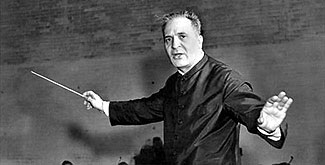 First came a warm-up for the more challenging pieces ahead: the Divertimento in B-Flat, K. 287 (minus its first minuet), in a big-band setting for the full ensemble played with both spirit and geniality – and some precarious ensemble that suggests meager rehearsal, or perhaps just unfamiliarity with a new conductor. (Toscanini would program the same work – the only piece of Mozart's extensive social music he ever played – in a 1946 reading with greater precision and firmer tempos that could be heard as stylish in the sense of Mozart needing no embellishment.) Next, in a display of versatility that Toscanini couldn't match, came the Piano Concerto # 20 in d featuring Walter as both soloist and conductor, swifter overall than his 1937 Vienna Philharmonic recording and with greater differentiation between pressing the orchestral portions and relaxing for his solo sections. The concert closed with the Symphony # 40, still quite muscular but with more moderate pacing and far better integration and attention to refined details than the 1929 Staatskapelle set (and far more pliant than Toscanini's own taut and rather rigid 1939 NBC recording).
First came a warm-up for the more challenging pieces ahead: the Divertimento in B-Flat, K. 287 (minus its first minuet), in a big-band setting for the full ensemble played with both spirit and geniality – and some precarious ensemble that suggests meager rehearsal, or perhaps just unfamiliarity with a new conductor. (Toscanini would program the same work – the only piece of Mozart's extensive social music he ever played – in a 1946 reading with greater precision and firmer tempos that could be heard as stylish in the sense of Mozart needing no embellishment.) Next, in a display of versatility that Toscanini couldn't match, came the Piano Concerto # 20 in d featuring Walter as both soloist and conductor, swifter overall than his 1937 Vienna Philharmonic recording and with greater differentiation between pressing the orchestral portions and relaxing for his solo sections. The concert closed with the Symphony # 40, still quite muscular but with more moderate pacing and far better integration and attention to refined details than the 1929 Staatskapelle set (and far more pliant than Toscanini's own taut and rather rigid 1939 NBC recording).
Unusual Programming – Although largely adhering to standard repertoire of the classical and romantic eras, beyond the Mozart Divertimento Walter led two baroque-era G-Minor concerti grossi. His Corelli "Christmas Concerto" is typical for the time – swelled and romanticized with heavy bass, thick textures, broad dynamics, wide vibrato and minimal grace. Handel's Op. 6 # 6 is slightly more animated, but still thick, dark and hefty overall (and further weighed down by a prominent piano continuo). D'Indy's rarely-heard but colorful Ishtar (notable for its inverse structure, in which the theme emerges only at the end after passing through variations) seems inert compared to its far more vital (and only pre-stereo) 1945 recording by Pierre Monteux and the San Francisco Symphony. A final oddity is a straight-forward reading of Daniel Gregory Mason's Old English Folk Song Suite. Although he led his share of then-recent works toward the dawn of his career, Walter had no stomach for truly modern music – he called atonality "as senseless as a rebellion against the laws of physics" and an effort to subvert the soul with intellect; for that matter, he snubbed jazz as insulting, debasing, a caricature of music and appealing to lower instincts. Mason's pleasant ramble was contemporary only in the sense of having been written in 1934, as it reflected the style of an earlier century. As Mason was American, perhaps Walter programmed it as a patriotic gesture toward his newly adopted country.
Disjointed – Just to get the few other letdowns out of the way � 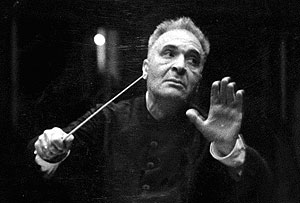 A Beethoven Symphony # 1 and a Schubert Symphony # 5 both would seem especially amenable to Walter's typical glowing warmth and their unassuming structures would seem to invite steadfast readings, and yet the outset of the Beethoven is torn by seemingly random propulsion and inertia before settling down and the modest Schubert begins gruff and thick but ends with an assertive Scherzo and a hectic finale. Perhaps rather than a disappointment or lapse they signal that for his NBC concerts Walter was not content to fall back on his natural inclinations but was seeking a new path, had already absorbed some of the American spirit of daring and invention, and was prepared to assume risks that until now had lain dormant in his artistic outlook.
A Beethoven Symphony # 1 and a Schubert Symphony # 5 both would seem especially amenable to Walter's typical glowing warmth and their unassuming structures would seem to invite steadfast readings, and yet the outset of the Beethoven is torn by seemingly random propulsion and inertia before settling down and the modest Schubert begins gruff and thick but ends with an assertive Scherzo and a hectic finale. Perhaps rather than a disappointment or lapse they signal that for his NBC concerts Walter was not content to fall back on his natural inclinations but was seeking a new path, had already absorbed some of the American spirit of daring and invention, and was prepared to assume risks that until now had lain dormant in his artistic outlook.
The Triumphs – Walter seemed to have saved his peak inspiration (and his players' focus and stamina) for the major works with which he concluded most of his NBC concerts with an abundant infusion of vibrant energy that stands in striking contrast to his prior recordings (and the NBC's concerts with its primary conductor).
- Mahler: Symphony # 1 – Walter's Vienna concerts explored the late, autumnal Mahler, and here we have our first document of his approach to Mahler's more youthful work (this one written at 28). Although Walter was already 63, he embarks with athletic vigor and eager versatility in a winning fusion of brash energy and poetic sensitivity. The second movement in particular, thick with peasant lustiness amid recollections of Viennese finesse, asserts the power of Walter's personality to extract from Toscanini's orchestra such subtle infusions well beyond the Maestro's interpretive arsenal. The finale seethes with probing expectation and robust vitality in what perhaps is our most credible indication of how Mahler himself viewed his early work.
Bruckner: Symphony # 4 – Although he became known as a Bruckner specialist, Walter came to Bruckner relatively late in life. This, our first evidence of his approach, is altogether stunning, a deeply personal interpretation a universe apart from any other, including Walter's own later renditions. The first movement veers wildly from frenetic climaxes to extreme torpor, tearing the texture with blaring brass and ripping the structure apart with distinct sections and a disregard of preserving the basic pulse. Next the Andante radically shifts gears, repressing passion with mild, slow, patient surges until a frantic climax. The Scherzo is furiously driven, without regard to the orchestra's utter inability to keep pace, relieved temporarily by a tender trio. After all that, the finale seems surprisingly moderate, as though the music itself reels with exhaustion.
Tchaikovsky: Symphony # 5 – Walter took little interest in Tchaikovsky and that seems a shame; after the acoustic "Path�tique" this is our only Walter recording of a Tchaikovsky symphony and it's terrific, bracketed by an altogether gripping first movement smoothly balanced between intense emotional underlining and lovely lyricism and a dignified finale that relentlessly holds back the floodgates to accentuate a final burst of energy. Walter's considered restraint seems all the more extraordinary when compared to a turbulent 1941 concert with the same orchestra in which Stokowski constantly distends the dramatic content of the music to the breaking point – more immediately striking, but perhaps ultimately less satisfying.
Strauss: Don Juan and Death and Transfiguration – The score of Don Juan is so fully characterized as to require little creative input for total effect,
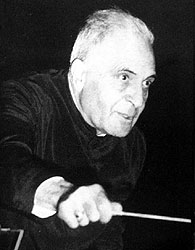 and Walter conveys the full panoply of its shifting emotions. By contrast, Death and Transfiguration suddenly heaves between wallowing in despair and exploding in feverish ecstasy, and Walter accentuates a super-charged account of the sudden climaxes, the contrast between the disparate sections far more magnified than in his acoustic recording.
and Walter conveys the full panoply of its shifting emotions. By contrast, Death and Transfiguration suddenly heaves between wallowing in despair and exploding in feverish ecstasy, and Walter accentuates a super-charged account of the sudden climaxes, the contrast between the disparate sections far more magnified than in his acoustic recording.Brahms: Symphony # 1 – Unfortunately, the only transfer I've heard of this performance is soured with excessive wow (severe speed variation), possibly a defect in the original that would require a sophisticated computer program to rectify. Even so, despite the compromised sound, the outer movements emerge as far more vital than in Walter's earlier 78 set and far more deeply inflected and with far more visceral excitement than the steadfast focus and precision of Toscanini's own 1940 NBC concert.
Schubert: Symphony # 9 – Here, too, the differences are striking between this vibrant, engaged reading and both Walter's routine prior studio recording and Toscanini's steady, focused if rather impersonal 1938 NBC concert rendition. If the second movement and finale seem tame and somewhat conventional with relatively steadfast pacing, it's only by comparison with the compelling sense of architecture that emerges from the opening movement's smooth transitions among Walter's extreme pacing of the assertive and reflective portions; a reflection of that approach adds considerable and uncommon interest to the Scherzo.
Haydn: Symphonies #s 86 and 92 – As though to display Haydn's variety, as well as his own versatility in repertoire that few took seriously at the time, Walter provides vastly different views of these two Haydn symphonies. # 92 is thoroughly stylish and magnificently well-integrated, beginning with an Allegro spiritoso that's spirited enough yet suitably delicate, proceeds to an Adagio cantabile that displays careful dynamic control for structural definition and a Menuetto that irrepressibly invites visions of dancing that, in turn, ends with a finale bursting with vigor and drive. # 86, though, reflects Haydn's wicked humor by building rather teasingly with a lively opening, a lush Capriccio and an emphatic but patient Menuetto that barely prepare us for the finale that startles as harsh, adamant, rough-hewn and furiously-driven.
Lest the foregoing comparisons with roughly contemporaneous NBC concerts led by Toscanini point to a consistent fundamental difference (and perhaps Walter's intent to underscore his individuality from a preeminent but intolerant rival, who reportedly once walked out of a Walter rehearsal in disgust), we should note that some of their performances were strikingly similar, including a Mozart Symphony # 35 and a Brahms Symphony # 2, both of which emerge as only slightly more personal and just a bit more rousing under Walter's baton. Yet the dearth of such instances suggests mere coincidence rather than any degree of conscious emulation.
It's tempting to credit Walter's remarkable if brief output with the NBC to some unique chemistry between him and the orchestra. On the one hand the musicians might have welcomed a respite from the dictatorial Toscanini. At the same time, being relatively newly-formed, they had not yet calcified into a uniform "sound." Yet we have a handful of Walter's concerts from the same period with other ensembles that display much of the same distinctive fervor. The finale of a 1942 New York Philharmonic Bruckner Symphony # 8 startles with its unbridled discontinuity that attacks and dismantles the patient edifice built up in the earlier movements. 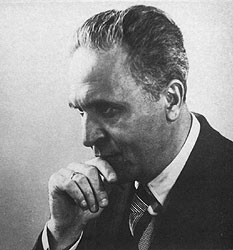 A 1943 NY Philharmonic Haydn Symphony # 88 scrambles through a delirious 2'50" finale (a full half-minute faster than Toscanini's 1938 NBC reading). A 1941 Philharmonic Debussy La mer eschews wild tempos but surges with bold splashes of color that transcend the dismal sound. And a Dvorak "New World" Symphony from a 1942 Standard Symphony Orchestra concert in Los Angeles begins with intense drama as slashing climaxes smoothly glide into exquisite tenderness, the Scherzo bursts out after the calming lull of the soothing Largo, and the finale follows clipped opening chords with grim exhaustion (grounded by pronounced but muffled tympani) until a final gallop at the end. A Tchaikovsky Romeo and Juliet Overture from the same concert projects extreme contrast between the lyrical and adrenalized sections. (Unfortunately we are at a loss to evaluate the converse situation – comparing Walter's NBC concerts with those led by other guest conductors – since so few are available; we do have some in the early 1950s by Cantelli, but that was a decade later and he was Toscanini's prot�g� and thus not unexpectedly followed in the Maestro's proverbial footsteps.)
A 1943 NY Philharmonic Haydn Symphony # 88 scrambles through a delirious 2'50" finale (a full half-minute faster than Toscanini's 1938 NBC reading). A 1941 Philharmonic Debussy La mer eschews wild tempos but surges with bold splashes of color that transcend the dismal sound. And a Dvorak "New World" Symphony from a 1942 Standard Symphony Orchestra concert in Los Angeles begins with intense drama as slashing climaxes smoothly glide into exquisite tenderness, the Scherzo bursts out after the calming lull of the soothing Largo, and the finale follows clipped opening chords with grim exhaustion (grounded by pronounced but muffled tympani) until a final gallop at the end. A Tchaikovsky Romeo and Juliet Overture from the same concert projects extreme contrast between the lyrical and adrenalized sections. (Unfortunately we are at a loss to evaluate the converse situation – comparing Walter's NBC concerts with those led by other guest conductors – since so few are available; we do have some in the early 1950s by Cantelli, but that was a decade later and he was Toscanini's prot�g� and thus not unexpectedly followed in the Maestro's proverbial footsteps.)
So what did happen to so radically change Walter's musical personality?
Walter generally embraced a rose-tinted view of politics, society, colleagues and family, relying upon music as a force for human betterment by striving for consonance amid dissonance, radiating optimism and lifting us above the mundane to a higher plane of spiritual existence. Yet for once his self-imposed serenity may have been shattered, as he was going through the roughest patch of his life. He had tried to accommodate anti-Semitism from the outset of his career when he changed his surname and converted to Catholicism (as had Mahler) in the hope of mollifying cultural gatekeepers but to increasingly little avail, as the German press taunted by referring disparagingly to his given name of Schlesinger and questioning his racial fitness to convey "true" German art. As the Nazis solidified their grip on Europe, he was banished from concert halls in all the cultural centers of the continent where he focused his career. Of the three women closest to him, one daughter was murdered by her jealous husband, the other was harassed by the police and his wife slipped into permanent depression. He was warmly welcomed in America and claimed membership in a "community of human spirit beyond centuries and mundane boundaries – an invisible church that had sheltered me from the innumerable attacks with which the events of daily life shake man's power of resistance. � Music proclaims in a universal language what the thirsty soul of man is seeking beyond this life." And yet he was a spiritual refugee, torn away from the physical and cultural comfort of all he had known and adrift in a new and uncertain world. Surely Walter felt some of the same internal turmoil as Furtw�ngler, who poured into his matchless Wartime concerts his internal agony over the dissolution of the culture in which he had been so deeply immersed and whose interpretations transmuted the collision of art, politics and morality into music of unprecedented power. Perhaps in light of the Nazis' seemingly invincible grip over Europe Walter feared for the future of Western civilization and at the same time absorbed some of the intrepid brashness that typified the art of his adopted country.
There's also something special about concerts. 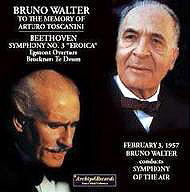 At first it seems counterintuitive – shouldn't an artist be willing to take more risks in the studio where miscalculations or gaffes can be redone (or, in the tape and digital eras, repaired with patches from parallel takes) than in the concert hall where time is immutable and there are no second chances? Yet the opposite is true – any such artistic reticence is routed by the electrifying presence of an audience and its stimulation. Not only in classical music but in jazz, blues, rock, reggae – indeed, any genre – our most absorbing recordings invariably are made during concerts. As an extreme example, Furtw�ngler's vast reputation is almost wholly based on tapes of his inspired broadcasts rather than his comparatively staid studio work. Indeed, Walter's early (1941-43) American studio recordings with the NY Philharmonic of Beethoven's Symphonies 3, 5 and 8 – according to Ren� Quonten, chosen by Columbia to compete with RCA's issuance of the same three symphonies by Toscanini and the NBC – and the "Emperor" Concerto with Serkin are solid but essentially mainstream readings and lack the heady inspirational freedom of his contemporaneous concerts.
At first it seems counterintuitive – shouldn't an artist be willing to take more risks in the studio where miscalculations or gaffes can be redone (or, in the tape and digital eras, repaired with patches from parallel takes) than in the concert hall where time is immutable and there are no second chances? Yet the opposite is true – any such artistic reticence is routed by the electrifying presence of an audience and its stimulation. Not only in classical music but in jazz, blues, rock, reggae – indeed, any genre – our most absorbing recordings invariably are made during concerts. As an extreme example, Furtw�ngler's vast reputation is almost wholly based on tapes of his inspired broadcasts rather than his comparatively staid studio work. Indeed, Walter's early (1941-43) American studio recordings with the NY Philharmonic of Beethoven's Symphonies 3, 5 and 8 – according to Ren� Quonten, chosen by Columbia to compete with RCA's issuance of the same three symphonies by Toscanini and the NBC – and the "Emperor" Concerto with Serkin are solid but essentially mainstream readings and lack the heady inspirational freedom of his contemporaneous concerts.
Walter would return twice to the NBC Symphony – in March 1951 to substitute for Toscanini who had injured his knee, and for a February 3, 1957 Toscanini memorial concert with the "Symphony of the Air," the remnants of the NBC Symphony which the network had disbanded after Toscanini's 1954 retirement but which survived for another decade both under guest conductors and in leaderless concerts intended to recall and preserve his spirit. Perhaps in deference to the occasion and the style of his late colleague, for his memorial tribute Walter crafted a rendition of the Beethoven Eroica, that melds Toscanini's resolute drive (and outsized tympani) with his own patient tempos and humanistic bent.
As with Mahler, Walter's European reputation was built at least as much at the opera house as in the concert hall. Yet, as with nearly all opera conductors, as he aged his career turned increasingly to orchestral concerts largely as a matter of stamina and efficiency – weeks of concerts could be prepared with the time and energy required for a single opera production.
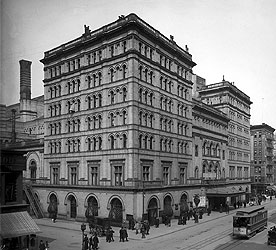 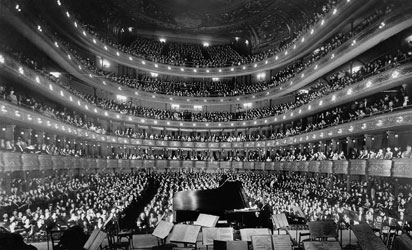 The old (pre-Lincoln Center) Met – "brewery" exterior; lavish interior |
Beethoven: Fidelio (February 22, 1941) – Our first complete opera directed by Walter in America is in many ways the most remarkable of all. In terms of sheer conducting, it's the most viscerally gripping and inspired Fidelio on record, constantly using tempo as an emotional barometer, but without threatening the continuity or effectiveness of the musical values or the characterization of the protagonists. Thus the opening duet is breathless but then relaxes for the central section of Marcellina's reverie and never quite recaptures the initial ardor – a fine depiction of the complex, conflicted emotions of a flighty youth facing the responsibilities of adulthood. The two overtures (Fidelio and Leonore 3) are utterly electrifying in their reckless speed and power and project a spontaneous outpouring rather than a patient construction of the recording studio. The two extended finales push the trite plot points far to the side and emerge as oratorios that throb with human passion to underscore the essential moral themes. Although our focus is on Walter, we should note that the singers are a dream cast: Kirsten Flagstad (Leonore), Ren� Maison (Florestan), Herbert Janssen (Don Fernando), Julius Huehn (Don Pizarro) and Alexander Kipnis (Rocco). Solo voices constantly quake with excitement to craft a deeply human document that explores complexity beneath the surface of the plain text, all the while projecting the essence of the characters. Even Pizarro impresses as a man of sincere (albeit misguided) conviction amid a lurking aura of evil rather than a one-dimensional archvillain of pure malevolence, and Rocco struggles to muster enthusiasm for his vile work as a prison flunky and thus summons the painful compromises we all face in life. Despite being preserved in relatively thin sound, this is an altogether exalting and exhilarating experience. Although this recording was of the second matinee performance, the opening night critics raved about Walter. Pitts Sanborn in The New York World Telegram dubbed it a "red letter night" at the Met and singled out as "a perpetual delight" Walter's "feeling for every phrase of the music and his understanding of its large design" that "wrought the audience to such a pitch of enthusiasm that one trembled for the safety of the august house." Francis D. Perkins in The New York Herald Tribune agreed that "for Mr. Walter's American operatic debut [Fidelio] is a work which he not only understands completely but loves whole heartedly, with his ability to communicate his enthusiasm to the artists on the stage, the musicians in the pit and to the hearers in the audience." Citing cheers, vigorous applause and ovations throughout the "exceptional success," he noted in particular that "Mr. Walter had to wait two minutes or more after an inspiring conclusion of the Third Leonore Overture before the demonstration subsided sufficiently to allow him to begin the final scene."
Mozart: Don Giovanni (March 7, 1942) – Next at the Met Walter reprised his Salzburg success, with Pinza again in the title role. This Don Giovanni still garners universal and ecstatic praise, not only for Pinza's full realization but for Walter's leadership.
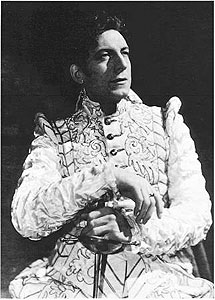 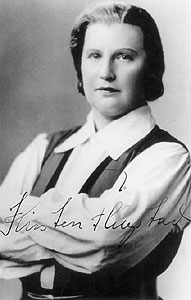 Ezio Pinza as Don Giovanni / Kirsten Flagstad as Leonora |
Walter followed his triumph of Don Giovanni with Le nozze di Figaro, another Salzburg Mozart reprise with Pinza, of which we have a full recording of the January 29, 1944 performance, and the Magic Flute, of which only a recording of a 1954 revival has emerged, together with Verdi's La forza del destino (recorded on January 27, 1943) and Un ballo in maschera (January 15, 1945), but while well received, none generated quite the ecstatic acclaim of Fidelio or Don Giovanni. (As a quirky aside, the Boston Herald critic found Walter's 1944 Figaro "wholly enchanting" but, possibly colored by wartime chauvanism, raised an objection: "What possible, conceivable excuse is there for doing this piece in Italian? It is perfectly preposterous to have a cast, more than half of which is American born, reciting jokes in a foreign language.")
Like so many esteemed European musicians who came to America during the War, immeasurably enriching our society and shifting the musical center of gravity further west across the Atlantic (just among conductors: Toscanini, Klemperer, Steinberg, Leinsdorf), Walter remained (and became a U.S. citizen in 1946). 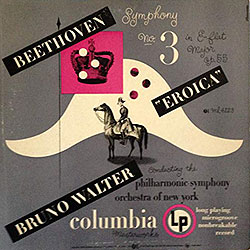
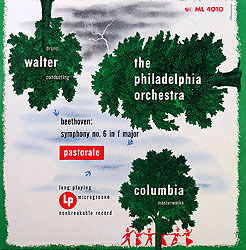 Although in demand for concerts throughout the U.S., for the final decade of the mono era he recorded almost exclusively for Columbia with the New York Philharmonic (then called the Philharmonic-Symphony Orchestra of New York), focusing on Mahler and complete cycles of the Beethoven, Brahms and late Mozart symphonies. All but the Mahler would be supplanted by stereo remakes and are rarely heard nowadays, but to many collectors they remain the peak of Walter's mature art.
Although in demand for concerts throughout the U.S., for the final decade of the mono era he recorded almost exclusively for Columbia with the New York Philharmonic (then called the Philharmonic-Symphony Orchestra of New York), focusing on Mahler and complete cycles of the Beethoven, Brahms and late Mozart symphonies. All but the Mahler would be supplanted by stereo remakes and are rarely heard nowadays, but to many collectors they remain the peak of Walter's mature art.
The Beethoven symphonies – Walter's Philharmonic Beethoven cycle actually began with two outliers – the solid 1941 Eighth, which was the most vivid of the three cut that year (and in 1948 had the honor of being the first recording released by Columbia in its new 10-inch LP format, bearing catalog number ML-2001); and a 1946 Sixth ("Pastoral") with the Philadelphia Orchestra, whose smooth, colorful sound was seemingly an ideal pairing for Beethoven's paean to nature. Yet while the first two movements are fluidly played and emerge as gentle and soothing without wallowing in sentiment the rest seems comparatively bland and disappointingly lethargic. Walter cut the other seven with the Philharmonic, beginning in 1947 with the First, nicely poised between light and depth, jaunty youth and a herald of the weightier symphonies to come. Next in 1949 came the Third ("Eroica") in an eminently musical reading that favors abstraction over highlighting its thematic overtones, fundamentally smooth and patient with just enough force to suggest rather than underscore its revolutionary spirit. The Ninth ("Choral") is a curious hybrid. First made and released intact in 1949, the finale was replaced in 1953 and the result reissued, both on a double LP with the 1941 Beethoven Eighth filling the fourth side and, by splitting the third movement, cramming all 66 minutes onto a single LP with surprisingly decent fidelity (although my pressing is afflicted with a bad speed change toward the end in the 2/2 section as the soloists and chorus sing "Tochter aus Elysium"). It's a decent, middle-of-the-road reading that was welcomed at the time but – and I admit that I've undoubtedly been spoiled by so many more distinctive Ninths – others have had much more to say in this remarkable landmark work. 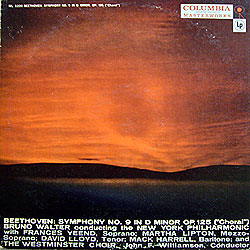
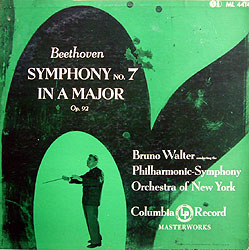 Walter's 1950 Fifth is two minutes slower than his 1941 version and takes a similar middle path in a work that others bend to their firm attitudes – Toscanini's unremitting vigor, Scherchen's reckless haste, Klemperer's granitic sturdiness, Furtw�ngler's mystical probing – impersonal, perhaps, but not in the sense of dull or uncaring, but rather letting the glorious music unfold inevitably and logically, neither dragging nor carried away.
Walter's 1950 Fifth is two minutes slower than his 1941 version and takes a similar middle path in a work that others bend to their firm attitudes – Toscanini's unremitting vigor, Scherchen's reckless haste, Klemperer's granitic sturdiness, Furtw�ngler's mystical probing – impersonal, perhaps, but not in the sense of dull or uncaring, but rather letting the glorious music unfold inevitably and logically, neither dragging nor carried away.
Two of the last three in the set display the greatest personality. 1951 brought a Seventh which displays the bounds of Walter's disposition of the time. The introduction avoids undue dwelling on atmosphere, the joy of the ensuing Vivace is tempered by a touch of gravity, the Allegretto molds plastic tempos into an empathetic whole, the Presto is thick but poised between dance and repose, and the finale is quick and energetic. The orchestral balance boosts the winds at the expense of strings (at least on my original LP; CD remastering might reduce it), thus anticipating the texture of historically-informed performances of a later generation. The Fourth (1952) is ideally paced, with sufficient power but always couched in expressive feeling, accents muted just enough to blend in and Walter's trademark lyricism well in evidence, at least until the finale which declines a temptation to soar. The final entry is a 1953 Second that opens patient and rich while moving forward without losing momentum but then bogs down in the Larghetto, recovers somewhat in the Scherzo and ends with an Allegro molto that just isn't all that molto. (Perhaps Walter was least fond of this one but dutifully included it to complete the cycle?) A supplement of sorts was a 1949 Triple Concerto with an especially tight-knit and home-brewed set of soloists – the orchestra's concertmaster John Corigliano, its first cellist Leonard Rose and its assistant conductor Walter Hendl on piano – for whom Walter provides an earnest setting, nurturing yet muscular and fleet, fully mindful of the genre's roots in the baroque era of less personal interpretive input.
Also worth noting is a live 1948 Missa Solemnis that crackles with volatile untamed fervor and elemental visceral excitement, constantly pushing tempos and dynamics to the extreme, drawing deeply committed singing and playing, and holding its sections together – but only barely – with thrilling tension. 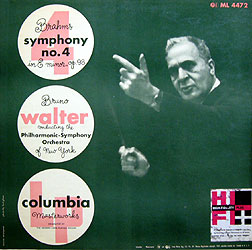
 Most commentators seem to deprecate it as unbalanced, undisciplined, ragged and worse, but while that all may be true, for me it's one of those rare transforming experiences after which no other sounds quite the same. The long gap of silence between the final note and the storm of applause attests to the depth of the spiritual impact this astounding performance had on its audience.
Most commentators seem to deprecate it as unbalanced, undisciplined, ragged and worse, but while that all may be true, for me it's one of those rare transforming experiences after which no other sounds quite the same. The long gap of silence between the final note and the storm of applause attests to the depth of the spiritual impact this astounding performance had on its audience.
The Brahms Symphonies – Walter recorded the four Brahms symphonies with the Philharmonic in inverse order. A February 1951 Fourth began the series auspiciously, centered around a delicate, flowing, organic Andante moderato in which the climax comes and subsides naturally with a rich, burnished glow; even the finale avoids others' fevered peaks and probing valleys in favor of a cohesive, patient unfolding. The remaining three were all cut in late December 1953 and in each case save their energy for propulsive finales – that of the Third flirts with hysteria – and begin with a variety of openings – the Third with fiery outbursts, the Second with exceptional polish and the First with climaxes repressed in favor of flexible tempos. Overall, these are good, responsible readings but without any particular vision or the special touches heard in so many other versions.
Other Walter/Philharmonic Brahms recordings from 1953-4 outshine their symphony cycle: a potent Tragic Overture, a spry Academic Festival Overture, a well-characterized Haydn Variations, the Double Concerto with Isaac Stern and Leonard Rose – like the symphonies somewhat rambling if solid and centered around a gorgeous Andante – and a beautifully paced and surprisingly energetic German Requiem with George London, Irmgard Seefried and the Westminster Choir, never rushed but always pressing forward with a strong rhythmic thrust, including overpowering timpani in the second movement, an extraordinary rarity in the entire Walter discography. Remarkably, this splendid rendition was never issued at the time; it was released only in 1972, and then on Columbia's budget Odyssey LP label.
Mozart – In his 1957 book, 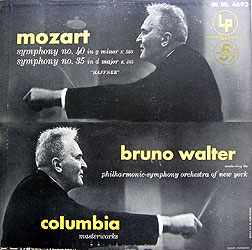
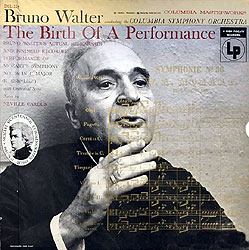 Walter wrote of Mozart's "profound understanding of human character and emotions" and his own aim of conveying "behind a seemingly graceful playfulness the dramatist's inexorable seriousness and wealth of characterization" and giving powerful dramatic expression to "a truth concealed behind the veil of beauty." Although his comments were directed primarily toward Mozart's operas, Walter's 1953-6 Philharmonic recordings of Mozart's last six symphonies amply fulfil this goal, unfolding richly and inevitably, with fully integrated spirit, power and warmth, and balances and tempos subtly adjusted to preserve the musical line and continuity. Nor does Walter slight three middle-period symphonies (#s 25, 28 and 29); while not representing Mozart's full maturity, he affords them appropriately fleet finales and lighter textures in their opening Allegros but thickens and darkens the middle movements. The "Linz" Symphony (# 36) was first issued as "The Birth of a Performance," a special double LP edition that precedes the final recording with 96 minutes of rehearsals that document all the fond anecdotal memories of Walter polishing a performance through gentle persuasion and professional respect. (Walter told Arnold Michaelis that the rehearsal taping was an "ambush" that he would not have allowed but ultimately came to approve with all his heart as an educational guide for young conductors learning to deal with an orchestra.)
Walter wrote of Mozart's "profound understanding of human character and emotions" and his own aim of conveying "behind a seemingly graceful playfulness the dramatist's inexorable seriousness and wealth of characterization" and giving powerful dramatic expression to "a truth concealed behind the veil of beauty." Although his comments were directed primarily toward Mozart's operas, Walter's 1953-6 Philharmonic recordings of Mozart's last six symphonies amply fulfil this goal, unfolding richly and inevitably, with fully integrated spirit, power and warmth, and balances and tempos subtly adjusted to preserve the musical line and continuity. Nor does Walter slight three middle-period symphonies (#s 25, 28 and 29); while not representing Mozart's full maturity, he affords them appropriately fleet finales and lighter textures in their opening Allegros but thickens and darkens the middle movements. The "Linz" Symphony (# 36) was first issued as "The Birth of a Performance," a special double LP edition that precedes the final recording with 96 minutes of rehearsals that document all the fond anecdotal memories of Walter polishing a performance through gentle persuasion and professional respect. (Walter told Arnold Michaelis that the rehearsal taping was an "ambush" that he would not have allowed but ultimately came to approve with all his heart as an educational guide for young conductors learning to deal with an orchestra.)
The flood of other Walter Mozart recordings from this era, presumably to honor (and for Columbia to cash in on) the 200th anniversary of the composer's birth, include a fine set of overtures (a Figaro unafraid to unwind in the expressive middle section; a Cos� that neatly assimilates the assertive masculine and playful feminine phrases; an Impressario that's all heady dominance), an Eine kleine nachtmusik that respects its fundamental buoyancy with barely a hint of profundity and, above all, a fully heartfelt Masonic Funeral Music that surges with life, swirling with complex feelings of regret rather than brooding in mere loss. Rather surprisingly, a March 1956 Requiem seems unengaged, perhaps reflecting Walter's mixed feelings toward the venue in anticipation of presenting it as his final appearance at the Salzburg Festival that summer.
Mahler – Walter may have claimed to have achieved a special understanding of Mozart, but he was hardly the only artist so enlightened. 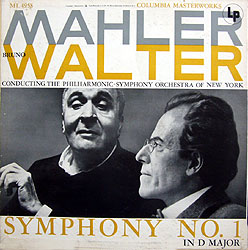
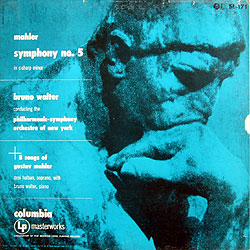 As an ambassador of Mahler, though, he was unique. Following settlement of the 27-month musicians strike in November 1944, Walter's return to the studio was for another Mozart Jupiter and then the very first recording of the Mahler Fourth. At the time of its creation Mahler had relied on Walter to explain the Fourth to critics and in his Mahler biography Walter described it as dreamlike and unreal, a fairy tale of airy imponderability and blissful exaltation. His recording is deeply caring, with an utterly natural flow, shorn of even a hint of exaggeration and, at 50 minutes, the swiftest on record, yet with no sense of being rushed. As an added touch of authenticity, his soloist in the sung finale is Desi Halban, daughter of Selma Kurtz who had studied and performed extensively with the composer and who presumably shared her unique insights with Halban. 1947 brought the Mahler Fifth in its own first recording. Dispatched in a mere 61 minutes, it may strike some as perfunctory when compared to vaunted subsequent recordings by, e.g., Barbirolli, Bernstein, Boulez, Haitink and Karajan that range from 69 to 75 minutes, but rather it surges forward convincingly and efficiently, unifying its episodes without wallowing in schmaltz and reveling in the coarse, rustic sound that was so intrinsic to Mahler. And lest it be suspected that Walter was impatient and unidiomatic, recall that while his Adagietto movement runs 7:35 (beating his earlier Vienna 78 by a half-minute), its only other recording by a Mahler acolyte (Mengelberg with the Concertgebouw in 1929) flies by in a mere seven minutes flat! And while not quite the first Mahler First (a version by Horenstein and the Vienna Symphony had appeared on Vox in 1953), Walter's 1954 Philharmonic LP of the First replicates much of the drive of his NBC concert with nearly identical timings but slightly smoother textures and overall continuity. Ryding recounts that Walter was impressed with the sound of a new Columbia record player and seized upon this recording to begin preserving a legacy of his interpretations. Indeed, he was so enthused that for the inner sleeve of the original release (ML 4958) he contributed pictures of personal memorabilia and extensive notes in which he characterized the symphony as the rebellion against God of a fiery young heart torn by inner conflicts, a view that certainly informs his potent rendition.
As an ambassador of Mahler, though, he was unique. Following settlement of the 27-month musicians strike in November 1944, Walter's return to the studio was for another Mozart Jupiter and then the very first recording of the Mahler Fourth. At the time of its creation Mahler had relied on Walter to explain the Fourth to critics and in his Mahler biography Walter described it as dreamlike and unreal, a fairy tale of airy imponderability and blissful exaltation. His recording is deeply caring, with an utterly natural flow, shorn of even a hint of exaggeration and, at 50 minutes, the swiftest on record, yet with no sense of being rushed. As an added touch of authenticity, his soloist in the sung finale is Desi Halban, daughter of Selma Kurtz who had studied and performed extensively with the composer and who presumably shared her unique insights with Halban. 1947 brought the Mahler Fifth in its own first recording. Dispatched in a mere 61 minutes, it may strike some as perfunctory when compared to vaunted subsequent recordings by, e.g., Barbirolli, Bernstein, Boulez, Haitink and Karajan that range from 69 to 75 minutes, but rather it surges forward convincingly and efficiently, unifying its episodes without wallowing in schmaltz and reveling in the coarse, rustic sound that was so intrinsic to Mahler. And lest it be suspected that Walter was impatient and unidiomatic, recall that while his Adagietto movement runs 7:35 (beating his earlier Vienna 78 by a half-minute), its only other recording by a Mahler acolyte (Mengelberg with the Concertgebouw in 1929) flies by in a mere seven minutes flat! And while not quite the first Mahler First (a version by Horenstein and the Vienna Symphony had appeared on Vox in 1953), Walter's 1954 Philharmonic LP of the First replicates much of the drive of his NBC concert with nearly identical timings but slightly smoother textures and overall continuity. Ryding recounts that Walter was impressed with the sound of a new Columbia record player and seized upon this recording to begin preserving a legacy of his interpretations. Indeed, he was so enthused that for the inner sleeve of the original release (ML 4958) he contributed pictures of personal memorabilia and extensive notes in which he characterized the symphony as the rebellion against God of a fiery young heart torn by inner conflicts, a view that certainly informs his potent rendition.
Walter ventured back to Europe for his only two post-war studio recordings outside the U.S. – key Mahler vocal works with the Vienna Philharmonic and Kathleen Ferrier, for whom Walter had the highest regard. 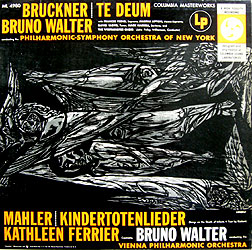
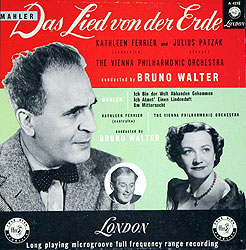 He called their collaboration "one of the most significant encounters of my artistic life. � The lovely timbre of her voice moved me, when I first heard it, as hardly any other sound ever has. And she had a soul as well as a voice. That soul knew and resounded the very soul of Mahler. I have often thought how much it would have meant to him to hear the profound understanding in her performances." Critics still tout their 1949 Kindertotenlieder and 1952 Das Lied von der Erde (with tenor Julius Patzak) as the most moving on record. By 1952 Ferrier was fatally ill and thus invested her part of Das Lied, and especially the final farewell, with an exceptional degree of personal identification. Although her persistent wide vibrato may not be to all tastes, her rich expressivity and feeling of throttled power are indeed poignant. Das Lied was Walter's only non-Columbia recording of the era, for which Decca's sound was extremely detailed and undoubtedly aimed to reproduce well on typical bass- and treble-deficient record players of the time. (The cover of the Kindertotenlieder LP had a grim if appropriate graphic [the title means "Songs on the Death of Children"], although the substantial album notes compensated in a way by addressing only the more upbeat companion – the Bruckner hymn of praise Te Deum.)
He called their collaboration "one of the most significant encounters of my artistic life. � The lovely timbre of her voice moved me, when I first heard it, as hardly any other sound ever has. And she had a soul as well as a voice. That soul knew and resounded the very soul of Mahler. I have often thought how much it would have meant to him to hear the profound understanding in her performances." Critics still tout their 1949 Kindertotenlieder and 1952 Das Lied von der Erde (with tenor Julius Patzak) as the most moving on record. By 1952 Ferrier was fatally ill and thus invested her part of Das Lied, and especially the final farewell, with an exceptional degree of personal identification. Although her persistent wide vibrato may not be to all tastes, her rich expressivity and feeling of throttled power are indeed poignant. Das Lied was Walter's only non-Columbia recording of the era, for which Decca's sound was extremely detailed and undoubtedly aimed to reproduce well on typical bass- and treble-deficient record players of the time. (The cover of the Kindertotenlieder LP had a grim if appropriate graphic [the title means "Songs on the Death of Children"], although the substantial album notes compensated in a way by addressing only the more upbeat companion – the Bruckner hymn of praise Te Deum.)
A 1947 set of Mahler songs with Halban affords a nearly unique opportunity to hear Walter on the piano without an orchestra. (In 1941 recordings he also had accompanied Lotte Lehmann in Schumann's Dichterliebe and Frauenliebe und -Leben song cycles.) Of course, playing a solo instrument, even as an accompanist, affords far more flexibility than coordinating an entire orchestra. Indeed Walter is extraordinarily vital and rhythmically alive (recalling the quirky rubato in the four piano rolls Mahler cut in 1905) especially in the second Frauenliebe song, "Scheiden und meiden," in which no two notes seem to fall where they would be expected, aptly reflecting a sweetheart's conflicted thoughts as her beloved departs.
And the rest �
Schubert: Symphonies 5, 8 and 9 – While one would love to have heard Walter accompanying Schubert' masterful songs, we do have a set of his best-known symphonies. 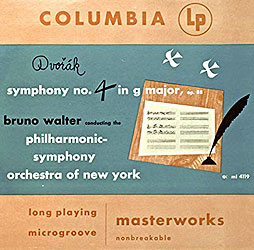
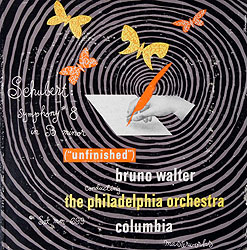 A 1946 "Great" Symphony # 9 proceeds along lines similar to his 1938 London recording but is more diffuse and squanders much of the assertive profile of the NBC concert. A 1947 "Unfinished" with the Philadelphia Orchestra largely replicates the splendor of the Vienna recording a decade earlier with a rich blend of carefully-controlled dynamics and textures. Yet a 1955 Fifth eclipses Walter's prior readings by investing the teenage composition with considerably more innocent grace than his earlier NBC concert.
A 1946 "Great" Symphony # 9 proceeds along lines similar to his 1938 London recording but is more diffuse and squanders much of the assertive profile of the NBC concert. A 1947 "Unfinished" with the Philadelphia Orchestra largely replicates the splendor of the Vienna recording a decade earlier with a rich blend of carefully-controlled dynamics and textures. Yet a 1955 Fifth eclipses Walter's prior readings by investing the teenage composition with considerably more innocent grace than his earlier NBC concert.
Barber: Symphony # 1 (1945) – Although he played his share of new music in concerts toward the start of his career, this recording stands out only because it was the sole contemporary work Walter ever recorded. Neo-romantic (and cut in the same first post-strike session as the Mozart "Jupiter" Symphony), it didn't threaten to breach Walter's avowed disdain for truly modern music. Barber described it as "a synthetic treatment of the four-movement classical symphony" in which three themes appear throughout and retain their fundamental character. Walter gives it a dutiful reading.
Mendelssohn: Violin Concerto (with Nathan Milstein, 1945) – If proof were needed of Walter's flair for concerto accompaniment, here he fashions a superb complement to the sheer clarity and supple beauty of Milstein's playing. Originally released on three 12" 78s, this is the only Walter recording to have been issued on "V-Disc" for the military to distribute overseas for troop morale. Although its 25 minutes hardly required two full sides, it also goes down in history as the first 12" LP issued by Columbia (catalog # ML-4001, joining the transfer of Walter's 1941 Beethoven Eighth as Columbia's first 10" LP), Less fortunately, it also inaugurated the insipid, pointless "tombstone" design that would desecrate so many Columbia LP covers for years to come. 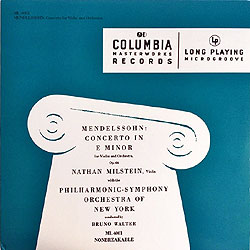
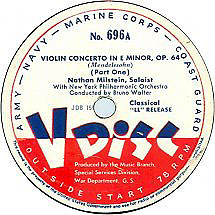 (Sheer ugliness aside, admittedly it was cheaper to plug new title and performer information into a generic image than to pay artists to design appropriate specific covers.) Speaking of meaningless gestures, Columbia also cut a 1947 remake of the Walter/Szigeti Beethoven Violin Concerto that reflected Szigeti's deteriorating technique while adding little of consequence to their essentially similar 1932 British Symphony recording beyond marginally better sound.
(Sheer ugliness aside, admittedly it was cheaper to plug new title and performer information into a generic image than to pay artists to design appropriate specific covers.) Speaking of meaningless gestures, Columbia also cut a 1947 remake of the Walter/Szigeti Beethoven Violin Concerto that reflected Szigeti's deteriorating technique while adding little of consequence to their essentially similar 1932 British Symphony recording beyond marginally better sound.
Haydn: Symphonies 96 and 102 (1953-4) – # 96 boasts lighter textures and more precise articulation (and thus seems more classical and "Haydnesque") than the 1938 Vienna Philharmonic recording. # 102 is a superb realization – thicker but more spirited in keeping with its deeper essence, and with an especially heartfelt Andante.
Bruckner: Te Deum (1953) – In Walter's first studio recording of a composer with which he was often identified, the vocal Te Deum stands in stark contrast to his deeply personal impassioned concert accounts of the Symphony # 4 (NBC, 1939) and Symphony # 8 (NY Philharmonic, 1942). Walter wrote that he viewed the Te Deum as a hymn in praise of God by a deeply pious man, and here he strips it of rhetoric and largely flattens the emotional peaks until a surge at the very end – more reverential than enraptured. It was recorded in the same session as the replacement finale of the Beethoven Ninth which seems apt, as Walter often programmed the two works together, yet it seemed far less fitting as coupled on LP with the gloomy 1949 Ferrier/Walter/Vienna Mahler Kindertotenlieder.
Dvorak: Symphony # 8 (1947) – Walter recorded precious little of Dvorak, a composer whose innate lyricism would seem custom-made for his musical personality. At the risk of occasionally sounding rushed, Walter constantly charges the inherent rustic allure of the Dvorak Eighth (then still referred to as the Fourth) with a sense of urgent vitality unique among all its other recordings I've heard, and yet the Adagio does manage to project all its abundant charm and the Scherzo is irresistibly bouncy while tinged with melancholy. 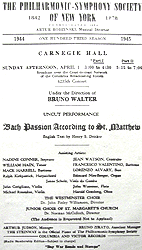
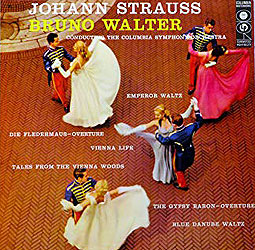 In marked contrast, the Bohemian Smetana Moldau is lamentably bland in a 1941 recording.
In marked contrast, the Bohemian Smetana Moldau is lamentably bland in a 1941 recording.
The Strausses – Walter's last pre-stereo 1956 sessions were devoted to four waltzes and two overtures of Johann Strauss. Unlike his first disparate Strauss discs, here his readings are unified with crisp but nimble articulation, pliant but engrossing rhythm and just a touch of tasteful elegance. As for the "other" Strauss, Richard's Don Juan and Death and Transfiguration (both 1952), are decent enough, but barely characterized and there is an abundance of far more compelling recordings, including Walter's own.
Bach: St. Matthew Passion (1945) – Aside from the astounding NBC concert series, I've adhered mostly to commercially-released studio recordings, but this one seems to demand a compelling exception. Despite professing the highest regard for Bach ("music of the deepest feeling in overwhelming profusion"), Walter never recorded any of his work, and this is the most substantial concert souvenir, albeit only of an abridged Part I, in English ("so that the words in conjunction with the music should make an immediate emotional impression on the listeners," according to Walter) and in characterless sound. Devoting a full chapter of his final book to the St. Matthew Passion, Walter recalled leading ten annual Easter performances in Munich and justified personalizing ornamentation and deviating from Bach's resources so as to "make allowance for the musical and emotional requirements of the work and the acoustic properties of our large concert-halls." Beyond noting that the performance seems heartfelt and well characterized, I'll leave further comment to those for whom the work has deeper personal meaning, while noting that Walter himself reportedly was overcome with emotion during rehearsals, thus perhaps proving the sincerity of his religious conversion. For me the most regrettable omission from Walter's rich discography is Bach's instrumental music; we can only imagine the heartfelt splendor he would have brought to the Brandenburgs, Orchestral Suites or concerti.
Rather remarkably, all Walter's recordings through March 1956 were made only monaurally. Years earlier Columbia with its 12-inch 33 1/3 rpm long-playing records had won the classical "speed war" against its chief rival RCA (in retrospect a ridiculous fight for recording substantial works, as RCA's 7-inch 45 rpm discs held no more music, had lower fidelity and its thin grooves were more susceptible to audible damage than the 78s they were to replace). Yet Columbia fell behind in preparing for the next technological revolution, as RCA had been taping in stereo since March 1954. As had happened three decades earlier when electrical recording supplanted the acoustic process, Columbia was eager to freshen its catalog with the new technology once home reproduction became feasible, even though few buyers were yet equipped to benefit from the new records (which were fully compatible with mono players with a simple stylus upgrade). Even so, the lure of the new was an essential marketing point, and Columbia was keen to approach its superstar conductor with the prospect of immortalizing his interpretations in stereo.
Two personal factors made the timing propitious. In March 1957 Walter suffered a heart attack, and then another as he was recovering, mandating a year of forced relaxation, curtailed activity and, presumably, an opportunity to reassess. 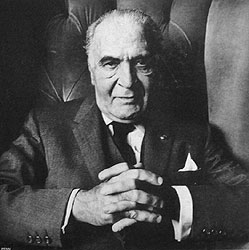 He also had become an adherent of anthroposophy, which accentuated his life-long belief in music as a moral force with emphases on "higher spheres," the dangers of materialism and investing the practicality of life on earth with heavenly roots, an outlook that seemed to mesh with Walter's long-held convictions that music had cosmic origins, that its essence is religious and that the ear is an organ of the soul. I can't pretend to even begin to understand this philosophy, much less its application to music, but (along with his reduced energy) it seemed to color Walter's interpretations which came to attenuate emotion, soothe conflict and emphasize sheer beauty and harmony. As Walter put it in concluding his final book, he felt "wholly merged in an overwhelming feeling of all-embracing gratitude that fills my being and demands expression. My changeful, active, music-blessed life has come to rest in this feeling: in gratitude I live, look into the past, look into the future – and look on high."
He also had become an adherent of anthroposophy, which accentuated his life-long belief in music as a moral force with emphases on "higher spheres," the dangers of materialism and investing the practicality of life on earth with heavenly roots, an outlook that seemed to mesh with Walter's long-held convictions that music had cosmic origins, that its essence is religious and that the ear is an organ of the soul. I can't pretend to even begin to understand this philosophy, much less its application to music, but (along with his reduced energy) it seemed to color Walter's interpretations which came to attenuate emotion, soothe conflict and emphasize sheer beauty and harmony. As Walter put it in concluding his final book, he felt "wholly merged in an overwhelming feeling of all-embracing gratitude that fills my being and demands expression. My changeful, active, music-blessed life has come to rest in this feeling: in gratitude I live, look into the past, look into the future – and look on high."
Once before Walter's outlook had changed suddenly and radically when he had left his European base to settle in America. That time the change was from solidity and balance to sheer instinctive intensity. During the year of his forced withdrawal it happened again. With very few exceptions, a bright line can be drawn between the interpretive range within his 15 years recording with the New York Philharmonic (and indeed his entire European career before that) and his final three years of revisiting his core repertoire to create a legacy in stereo. Robert Marsh recounted: "Walter retained a certain nostalgia and affection for his earlier recordings � but largely he felt that his stereo productions were the true likeness of his musicianship and the primary documentation of his reputation for future generations." Yet with all due respect for Walter's self-perception and intentions, the vast majority of his final recordings dissipate the tension and conflict inherent in nearly all great music in favor of a flaccid sweetness that disavows their complexity and power. The difference is manifest in timings alone – as extreme examples, in just a few years Brahms's Song of Destiny swelled from 12� minutes to 15, Dvorak's Symphony # 8 from 30 to 35 and Mahler's Symphony # 1 from 48� to 52.
Even so, it would be wrong to suggest that Walter's late recordings should be prized less than the predecessors. (One critic scorned them as "a pale, timid imitation of what he once had been.") The Philharmonic versions, and indeed much of his prior European catalog, stand as solid exemplars of the conductor's art, and if one were pressed to choose a single Walter recording of a given work, the earlier ones might well be preferred. Indeed, in compiling the Sony Bruno Walter CD Edition, the editors included many mono Philharmonic versions rather than the remakes that were in stereo and in better sound.  And yet, as fine as they are they are far from unique, standing alongside numerous other accounts that also display the works in their full idiomatic glory. The late Walter stereo takes, though, are truly unique, if only because their warm, burnished glow stands apart from any other. While rarely a first choice, or a version to recommend for someone seeking an introduction to grasp the essence of a given work, they provide a singular perspective for those seeking to supplement their insight.
And yet, as fine as they are they are far from unique, standing alongside numerous other accounts that also display the works in their full idiomatic glory. The late Walter stereo takes, though, are truly unique, if only because their warm, burnished glow stands apart from any other. While rarely a first choice, or a version to recommend for someone seeking an introduction to grasp the essence of a given work, they provide a singular perspective for those seeking to supplement their insight.
When Walter returned to the studio in January 1958 it was with the so-called Columbia Symphony Orchestra, a designation occasionally applied to various ensembles throughout the 1950s and '60s not only for Walter but for Bernstein, Schippers and others in the label's roster. The name appears on a dozen or so of Walter's mono Columbia recordings (mostly of Mozart and Johann Strauss) which were cut in Columbia's 30th Street New York studio with a reduced complement of players from the New York Philharmonic. (Apparently this was a way to sidestep the Philharmonic's union contract which required any recording session to pay all its permanent members even if they didn't participate.) Yet all of Walter's stereo Columbia Symphony recordings were made across the continent in the American Legion Hall in Los Angeles. According to John McClure, who produced many of the sessions, the large concrete structure was selected because it "'spoke' immediately with the music, surrounding each sound instantaneously with a natural aural bloom. The reverberation-decay was smooth and bright with no audible slap-back, and the sound of the diesel trucks laboring up the Cahuenga Pass to the San Fernando Valley never penetrated to its rather monastic interior." Players for this "Columbia Symphony" were drawn from the Los Angeles Philharmonic and local film studios, with a goal to not emulate an existing orchestra with established habits but rather to afford Walter a neutral starting point from which he could fashion his own personal style. The number of musicians varied but generally was downsized from a full symphonic complement, thus producing a more succinct sonority. Due to his reduced stamina, sessions were scheduled on Mondays, Wednesdays and Fridays and limited to three hours, of which the first two generally were used for rehearsal (as there were no preparatory concerts), and then to record up to 20 minutes of music and to review playbacks.
Beethoven – The first sessions were devoted to refreshing Walter's catalog with seven Beethoven symphonies, beginning with # 1 (January 6 and 8, 1958) and # 8 (January 8, 10 and 13) – the least demanding and thus a logical choice to familiarize Walter, his musicians and the technical crew with the arrangements. 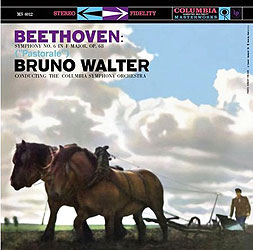
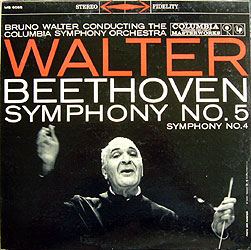 Both also happened to be two of the oldest in Walter's monaural cycle, which Columbia undoubtedly was most eager to update. Next on January 13, 15 and 17 came # 6 ("Pastoral"), a Walter specialty with which he clearly felt comfortable and the second oldest of his prior recordings (and the first of the new set to be released). Further sessions through February 10 then tackled the more challenging #s 3 ("Eroica"), 5, 7 and 4. Walter must have been thrilled with the sheer sound of the new recordings, as they boast a depth and a realistic soundstage that the earlier ones could only infer. The interpretive differences with his earlier sets are subtle in # 1 but then become increasingly more evident. Several tend to slow down as they progress. Thus # 8, ultimately weighing in at over two minutes longer, loses the thrust of the 1942 version's Menuetto and concludes with an Allegro vivace finale that is far from vivace, and the Pastoral, while engaging for its utter sense of unhurried beauty, presents an impotent storm barely redeemed by a rather weary prayer of thanks. One can only speculate as to the cause – was it flagging inspiration or a deliberate effort to cast Beethoven as a thoughtful builder grounded in earthly reality rather than a rebel? The ensuing Eroica presents more serious interpretive issues by largely blunting its inherent tension and conflict, although the overtly dramatic Fifth, despite disproportionately held first-movement fermatas, manages to exude an uncharacteristic (for late Walter) persistent, if even-tempered, power.
Both also happened to be two of the oldest in Walter's monaural cycle, which Columbia undoubtedly was most eager to update. Next on January 13, 15 and 17 came # 6 ("Pastoral"), a Walter specialty with which he clearly felt comfortable and the second oldest of his prior recordings (and the first of the new set to be released). Further sessions through February 10 then tackled the more challenging #s 3 ("Eroica"), 5, 7 and 4. Walter must have been thrilled with the sheer sound of the new recordings, as they boast a depth and a realistic soundstage that the earlier ones could only infer. The interpretive differences with his earlier sets are subtle in # 1 but then become increasingly more evident. Several tend to slow down as they progress. Thus # 8, ultimately weighing in at over two minutes longer, loses the thrust of the 1942 version's Menuetto and concludes with an Allegro vivace finale that is far from vivace, and the Pastoral, while engaging for its utter sense of unhurried beauty, presents an impotent storm barely redeemed by a rather weary prayer of thanks. One can only speculate as to the cause – was it flagging inspiration or a deliberate effort to cast Beethoven as a thoughtful builder grounded in earthly reality rather than a rebel? The ensuing Eroica presents more serious interpretive issues by largely blunting its inherent tension and conflict, although the overtly dramatic Fifth, despite disproportionately held first-movement fermatas, manages to exude an uncharacteristic (for late Walter) persistent, if even-tempered, power.
Perhaps it was a matter of becoming secure with the new orchestra and venue, but the final two of the seven seem the most compelling, repeating the excellence of the earlier cycle. Although a full three minutes slower, the insistent rhythm of the Seventh is subsumed by gentle progress and a stodgy trio is redeemed by a steadfast finale fueled by unusually prominent tympani. The Fourth, well-proportioned with all its pieces fitting together convincingly, is only slightly slower and nicely balanced with just enough energy to create a coherent whole. Completion of the Beethoven symphony cycle would await the next year with a similarly well-balanced Second centered around a ravishingly gorgeous Adagio and a remarkably effective Beethoven Ninth which achieves impressive power that complements rather than overrides an outpouring of lyricism and stands in marked contrast to a 1947 London concert in which (in nine fewer minutes) he unleashed the full realm of Beethoven's wide-ranging conception.  Incidentally, the 1959 Beethoven Ninth had a genesis even more curious than its mono predecessor – the first three movements were cut in five late January sessions under the usual arrangements in Los Angeles but Walter reportedly was dissatisfied with West Coast choruses and so the final choral movement was made in two April sessions in New York where the "Columbia Symphony" was an entirely different orchestra. Also to be cherished is an exquisitely sweet, if deliberately undernourished, January 1961 Beethoven Violin Concerto with Zino Francescatti.
Incidentally, the 1959 Beethoven Ninth had a genesis even more curious than its mono predecessor – the first three movements were cut in five late January sessions under the usual arrangements in Los Angeles but Walter reportedly was dissatisfied with West Coast choruses and so the final choral movement was made in two April sessions in New York where the "Columbia Symphony" was an entirely different orchestra. Also to be cherished is an exquisitely sweet, if deliberately undernourished, January 1961 Beethoven Violin Concerto with Zino Francescatti.
When Walter's first stereo Beethoven LPs were issued in 1958, they proudly boasted in a box at the top of the liner notes: "BRUNO WALTER AND THE SYMPHONIES OF BEETHOVEN / For a hundred and thirty-two years the nine symphonies of Beethoven have been in existence. For half that time – sixty-six years – Bruno Walter has been leading orchestras in renditions of these works." That's not strictly true – Beethoven's Ninth was completed in 1824, so in 1958 his symphonies had existed for 134 years, and so even if Walter's first concert had included a Beethoven symphony (unlikely, as he was associated with opera at the time), that would have been in 1894, or only 64 years before 1958. Even so, Walter's achievement was impressive indeed (although, by my count, among other conductors on record Klemperer, Mengelberg, Monteux, Schuricht and Stokowski all came very close, matched or even exceeded it).
Mahler – Walter's most ambitious undertaking of the stereo era, the Mahler Symphony # 2 ("Resurrection"), 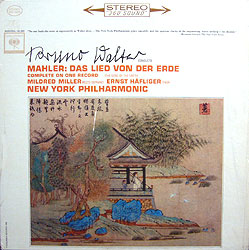
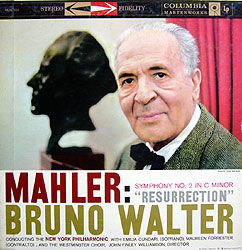 was another type of hybrid, as the first two movements were made in New York with the Philharmonic on February 18, 1957 in Walter's last recording session before his heart attack and then completed back in New York a year later on February 17 and 21, 1958. It also stands as one of the very few works he had not recorded before; reportedly he was upset with, but ultimately acceded to, his producers' insistence that he remake his core repertoire rather than add to it, thus threatening to deprecate and condemn his recent monaural body of work with the Philharmonic to obsolescence. While still garnering critical plaudits (Robert Marsh lauds it as "a landmark" and "how early Mahler ought to go if the genius is to show"), I tend to agree more with Tony Duggan who calls Walter's stereo Resurrection well-balanced and an "essential recording" and yet "a little limited in range and detail. � [T]here is more to be gleaned from this work and the fact that Walter does not do so is not a reflection of any inadequacies on his part, merely a reflection of the kind of man and artist he was, especially at that time of his life." For me, Mahler drenched his Resurrection with primal emotion and Walter's account, while far from dull, is overly cautious and polite, especially when compared to his somewhat more venturesome 1948 Vienna Philharmonic concert. Having witnessed its creation as Mahler finished the orchestral score and having prepared the piano reduction, it's true that Walter was more immersed in the Resurrection than anyone other than the composer himself, but that had been in 1896 and much water had passed under the proverbial bridge since then. Indeed, his reading pales beside those of Otto Klemperer, Mahler's only other prot�g� to have recorded the Resurrection, both in the studio (1963) and a Munich concert (1965) (plus an atypically frenetic 1951 Amsterdam concert), even though, late in his own life, Klemperer was hardly known for unbridled intensity.
was another type of hybrid, as the first two movements were made in New York with the Philharmonic on February 18, 1957 in Walter's last recording session before his heart attack and then completed back in New York a year later on February 17 and 21, 1958. It also stands as one of the very few works he had not recorded before; reportedly he was upset with, but ultimately acceded to, his producers' insistence that he remake his core repertoire rather than add to it, thus threatening to deprecate and condemn his recent monaural body of work with the Philharmonic to obsolescence. While still garnering critical plaudits (Robert Marsh lauds it as "a landmark" and "how early Mahler ought to go if the genius is to show"), I tend to agree more with Tony Duggan who calls Walter's stereo Resurrection well-balanced and an "essential recording" and yet "a little limited in range and detail. � [T]here is more to be gleaned from this work and the fact that Walter does not do so is not a reflection of any inadequacies on his part, merely a reflection of the kind of man and artist he was, especially at that time of his life." For me, Mahler drenched his Resurrection with primal emotion and Walter's account, while far from dull, is overly cautious and polite, especially when compared to his somewhat more venturesome 1948 Vienna Philharmonic concert. Having witnessed its creation as Mahler finished the orchestral score and having prepared the piano reduction, it's true that Walter was more immersed in the Resurrection than anyone other than the composer himself, but that had been in 1896 and much water had passed under the proverbial bridge since then. Indeed, his reading pales beside those of Otto Klemperer, Mahler's only other prot�g� to have recorded the Resurrection, both in the studio (1963) and a Munich concert (1965) (plus an atypically frenetic 1951 Amsterdam concert), even though, late in his own life, Klemperer was hardly known for unbridled intensity.
Beyond a lovely but needless remake of the Symphony # 1 that dissipates much of the stormy energy of the 1954 version, Walter's stereo sessions bestowed two thoroughly absorbing Mahler recordings. Walter characterized Das Lied von der Erde as having been written in the shadow of death, as Mahler recently had been diagnosed with an incurable heart defect. Although Walter was hardly young at the time of his acclaimed 1936 Vienna Das Lied concert, now he could more fully identify with the work in light of his own advancing age and medical deterioration. His April 1960 recording had further special resonance, as it was made in conjunction with a festival marking Mahler's centennial and the 50th anniversary of his first season as Music Director of the New York Philharmonic, an orchestra dear to Walter and with which this would be his last recording (and the related concert his last appearance with it). Paced at a far slower 63 minutes, the former drive is subsumed within a full-blooded depth and autumnal richness, radiating extraordinary sheen and polish. 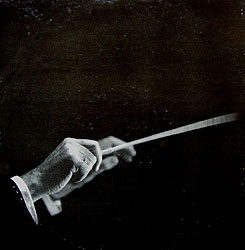
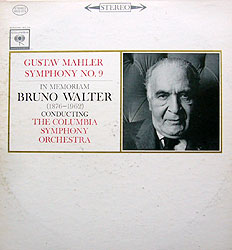 His mezzo-soprano soloist, Mildred Miller, effortlessly flits within the Philharmonic's variegated shade. The sheer beauty of the performance is as though Walter, like his mentor, sought to affirm his life by distilling his art into an enduring personal retrospective statement. The entire concluding song reportedly was secured in a single 29-minute first take. Walter was so pleased that after returning to California he recorded Miller in Mahler's Songs of a Wayfarer, and then Brahms's Alto Rhapsody the following year.
His mezzo-soprano soloist, Mildred Miller, effortlessly flits within the Philharmonic's variegated shade. The sheer beauty of the performance is as though Walter, like his mentor, sought to affirm his life by distilling his art into an enduring personal retrospective statement. The entire concluding song reportedly was secured in a single 29-minute first take. Walter was so pleased that after returning to California he recorded Miller in Mahler's Songs of a Wayfarer, and then Brahms's Alto Rhapsody the following year.
Fittingly, Walter's valedictory recording of Mahler was of his final work, the Symphony # 9. It, too, is a profoundly stirring reflection of life slipping away, from both composer and conductor. In Walter's hands the first climax sets the tone – the surging music builds and builds to a sustained leading note, its expectant power and triumph fueled by roiling tympani, only to glide ever so smoothly into an exhausted target chord. I've never heard a more poignant moment in any Mahler recording. While others have treated the work – and especially its inner Lander and Rondo-Burlesque movements – more forcefully, Walter's achievement is a unique meeting of artists' minds in which even the rough edges of life ultimately become viewed from a softened vista. In a heartfelt tribute after Walter succumbed to a final heart attack in February 1962, Columbia issued it in a memorial gatefold with an especially touching back cover graced by Walter's hands and baton.
Speaking of farewells, Walter's health limited him to only a few concerts each year but one in particular was of special import – a final May 29, 1960 concert with the Vienna Philharmonic featuring Mahler's Fourth, lovingly caressed over 60 minutes (vs. 50 for his 1945 New York account). Even more so than with the Mahler Ninth, conflict and friction are suppressed beneath a veneer of patient, wistful remembrance of both the work and the venue. Joseph Wechsberg noted that for almost sixty years Walter had been magically attracted, and was several times brutally rejected, by this most music-minded and music-filled city. Indeed, in 1948 after a decade of involuntary absence Walter still cherished the friendliness, warmth and humor of Vienna, the "home of music" where, in his words, "music learned how to smile." Wechsberg reported as he left: "An elderly woman went by and said to her husband, 'Come to think of it, it's amazing that Walter comes back here after what has happened to him in this city.' The man didn't answer. Maybe he didn't know the obvious: Walter came back in the service of Mozart and Schubert and Mahler."
Bruckner – � and Bruckner. 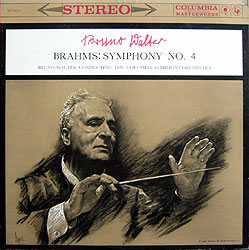
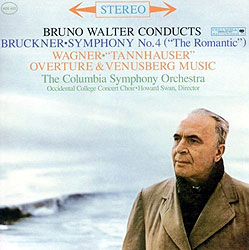 Many past conductors most active in Mahler (Mitropoulos, Bernstein, Abravanel) tended to shun Bruckner, while many of Bruckner's prime enthusiasts (Furtw�ngler, Abendroth, Knappertsbusch, Celibidache) ignored Mahler. Along with Klemperer, Walter advocated both, although aside from the 1953 Philharmonic Te Deum his only studio Bruckner recordings arrived with his stereo series. If the energy of his stereo Mahler can disappoint, his 1960 Bruckner Fourth compensates with a superlative reading offsetting generally slow pacing with crisp textures, carefully-graded dynamics, responsive tempo adjustments and an especially atmospheric Adagio full of foreboding. Alas, the outer movements of his Seventh sound tired, with strong dynamics but little tempo variation beyond slowing for climaxes, and indeed they were made during his penultimate March 1961 sessions as health issues presumably were sapping his vitality. The middle movements come off better – crisp, potent climaxes relieve the sustained mood of the Adagio and a lively Scherzo is only slightly dimmed by a drowsy trio. Given Walter's own deteriorating constitution, one might assume a special degree of identification with the Ninth, with which Bruckner struggled during his own final years and left incomplete. Indeed, while never trying to approach the sheer fury of Furtwangler's miraculous 1944 Berlin reading, a 1946 Walter Philharmonic concert had pliancy, momentum and a scorching Scherzo. His 1959 stereo outing is a full eight minutes slower with luminous, transparent textures, finely-tuned balances and a rather genial outlook, a gentle stroll into the twilight with head held high rather than fumbling with trepidation into the spooky uncertainty of looming darkness, as though strife and resistance against fate no longer seemed relevant after Walter's own brush with death. By coming to view Bruckner's complex grappling with mortality as idealized, spiritual harmony, Walter perhaps illuminated the composer's na�ve and sincere religious faith.
Many past conductors most active in Mahler (Mitropoulos, Bernstein, Abravanel) tended to shun Bruckner, while many of Bruckner's prime enthusiasts (Furtw�ngler, Abendroth, Knappertsbusch, Celibidache) ignored Mahler. Along with Klemperer, Walter advocated both, although aside from the 1953 Philharmonic Te Deum his only studio Bruckner recordings arrived with his stereo series. If the energy of his stereo Mahler can disappoint, his 1960 Bruckner Fourth compensates with a superlative reading offsetting generally slow pacing with crisp textures, carefully-graded dynamics, responsive tempo adjustments and an especially atmospheric Adagio full of foreboding. Alas, the outer movements of his Seventh sound tired, with strong dynamics but little tempo variation beyond slowing for climaxes, and indeed they were made during his penultimate March 1961 sessions as health issues presumably were sapping his vitality. The middle movements come off better – crisp, potent climaxes relieve the sustained mood of the Adagio and a lively Scherzo is only slightly dimmed by a drowsy trio. Given Walter's own deteriorating constitution, one might assume a special degree of identification with the Ninth, with which Bruckner struggled during his own final years and left incomplete. Indeed, while never trying to approach the sheer fury of Furtwangler's miraculous 1944 Berlin reading, a 1946 Walter Philharmonic concert had pliancy, momentum and a scorching Scherzo. His 1959 stereo outing is a full eight minutes slower with luminous, transparent textures, finely-tuned balances and a rather genial outlook, a gentle stroll into the twilight with head held high rather than fumbling with trepidation into the spooky uncertainty of looming darkness, as though strife and resistance against fate no longer seemed relevant after Walter's own brush with death. By coming to view Bruckner's complex grappling with mortality as idealized, spiritual harmony, Walter perhaps illuminated the composer's na�ve and sincere religious faith.
Schubert – The "Unfinished" Symphony had unfailingly been a Walter triumph, and he extended his winning streak, here with the Philharmonic, in a final studio version with an even more full-blooded first movement and an especially pensive second. His "Great" Symphony # 9 though, while well-played and arguably the best of his three attempts, is neither probing nor robust and remains in need of some point of view to develop and sustain interest throughout its sheer length and repetitiveness, falling well short of the novel vitality of his NBC concert. The Fifth tends to sail along on its own, albeit without the fragile gleam of Beecham's contemporaneous EMI account.
Brahms – As with his Philharmonic Brahms cycle,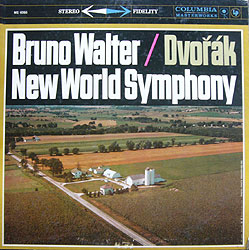
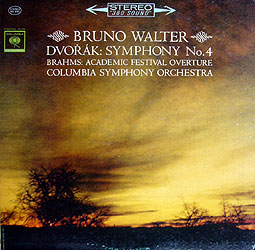 Walter first recorded the Fourth but here, after a meltingly smooth Allegro, tender Andante and invigorating Scherzo the finale is thoroughly mellow, drained of all its inborn tension and liberating drive. Indeed, in a major change from the mono readings none of the four Brahms symphony finales has the snap of invigorating the warmth of the prior movements. Rather, the Second and Third are bathed in comfort throughout (and for that very reason radiate a distinctive, albeit anomalous, outlook). The First mostly benefits from this approach, beginning with a sense of steady progress, attenuated drama, smooth transitions and creamy textures, only to founder with a wan finale that never breaks out of its inertia. Perhaps the apex of Walter's stereo Brahms lies not in the symphonies but his sweet, loving take on the Haydn Variations and a Double Concerto with Zino Francescatti and Pierre Fournier in which the soloists are nestled comfortably within a deeply empathetic orchestral fabric that provides a suitable bridge amid their intimate solo turns. Yet all is not soft and ripe – the Tragic Overture boasts crisp attacks and well-defined voicings, the Academic Festival Overture is a fine blend of spirit and pomp, and in the atmospheric Song of Destiny with the Occidental College Concert Choir a surge of energy surrounds a stirring central climax.
Walter first recorded the Fourth but here, after a meltingly smooth Allegro, tender Andante and invigorating Scherzo the finale is thoroughly mellow, drained of all its inborn tension and liberating drive. Indeed, in a major change from the mono readings none of the four Brahms symphony finales has the snap of invigorating the warmth of the prior movements. Rather, the Second and Third are bathed in comfort throughout (and for that very reason radiate a distinctive, albeit anomalous, outlook). The First mostly benefits from this approach, beginning with a sense of steady progress, attenuated drama, smooth transitions and creamy textures, only to founder with a wan finale that never breaks out of its inertia. Perhaps the apex of Walter's stereo Brahms lies not in the symphonies but his sweet, loving take on the Haydn Variations and a Double Concerto with Zino Francescatti and Pierre Fournier in which the soloists are nestled comfortably within a deeply empathetic orchestral fabric that provides a suitable bridge amid their intimate solo turns. Yet all is not soft and ripe – the Tragic Overture boasts crisp attacks and well-defined voicings, the Academic Festival Overture is a fine blend of spirit and pomp, and in the atmospheric Song of Destiny with the Occidental College Concert Choir a surge of energy surrounds a stirring central climax.
Dvorak – In a striking contrast with his 1947 Philharmonic reading, the urgency and turmoil of the Dvorak Eighth entirely cede to the trademark warmth and grace of Walter's final period. Thus the trumpet fanfare that launches the finale is no longer a command but rather an invitation to taste the country charm and lyricism of the ensuing variations. The Symphony # 9 ("From the New World") was new to the Walter discography. Not just the famous Largo but the entire work savors more of Bohemian nostalgia (sifted through the filters of Vienna and the contentment of Walter's final phase) than the spirit of American brashness and discovery, although it can seem a bit weary without the aggressive thrust with which Dvorak infused its abundant allure. Even so, both symphonies emerge as mature and wistful and provide a compelling complement to the standard renditions. Columbia graced both LPs with especially meaningful covers – for the Eighth a sunset to mark Walter's retirement the month after that recording and for the New World a slice of the rural, idyllic facet of America rather than typical images of the massive dynamism of its industrialized cities (although the back featured a charcoal sketch of the Brooklyn Bridge).
Mozart – It seems apt 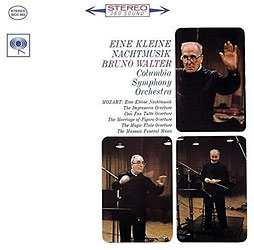
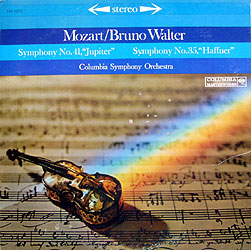 that Walter devoted his very last recording session of March 31, 1961 to his greatest love, Mozart. Alas, the overtures weigh in at up to 15% slower than his 1954 Philharmonic set, stripping them of their sense of youthful mischief and sheer joy. Also included, quite fittingly, is the Masonic Funeral Music but it, too, now plods along at 7'40" vs. 6'37". (All were packaged for release with an inflated, equally redundant and spiritually impaired late 1958 Eine kleine nachtmusik.) Although these were to be his last word on Mozart, fortunately they were preceded, and in all respects surpassed, by a stereo set of the late Mozart symphonies taped in January and December 1959 and February 1960. All but two movements are slower than in the mid-fifties mono renditions, often considerably so, but here the deliberation seems warranted to allow the complex wonders of these remarkable works to patiently unfold and to convey a sense of discovery, wonder and sheer admiration as their impression lingers and deepens. In a similar vein are tasteful December 1958 Mozart Violin Concertos # 3 and 4 with Zino Francescatti.
that Walter devoted his very last recording session of March 31, 1961 to his greatest love, Mozart. Alas, the overtures weigh in at up to 15% slower than his 1954 Philharmonic set, stripping them of their sense of youthful mischief and sheer joy. Also included, quite fittingly, is the Masonic Funeral Music but it, too, now plods along at 7'40" vs. 6'37". (All were packaged for release with an inflated, equally redundant and spiritually impaired late 1958 Eine kleine nachtmusik.) Although these were to be his last word on Mozart, fortunately they were preceded, and in all respects surpassed, by a stereo set of the late Mozart symphonies taped in January and December 1959 and February 1960. All but two movements are slower than in the mid-fifties mono renditions, often considerably so, but here the deliberation seems warranted to allow the complex wonders of these remarkable works to patiently unfold and to convey a sense of discovery, wonder and sheer admiration as their impression lingers and deepens. In a similar vein are tasteful December 1958 Mozart Violin Concertos # 3 and 4 with Zino Francescatti.
Haydn – At the outset of his final month of recording, and perhaps as a warm-up for the challenges of the Bruckner Seventh that lay ahead, Walter recorded two Haydn symphonies along lines comparable to his final take on the late Mozart symphonies but here with mixed results. His remake of the Symphony # 100 ("Military"), while advancing with patient and steady tempos, sounds more Viennese than his glum 1938 Vienna recording, as it is bolstered by somewhat delicate phrasing and expressive playing – as well as the Turkish percussion essential to its very nickname. But while the "Military" can bear the added weight, Walter's first and only shot at the daintier and diffident # 88 seems unduly guarded and tired, with a labored Largo and a dollop of spirit in the finale that sounds animated only by comparison to the rest. Neither seems to reflect the full range of Haydn's spirit. Although it seems unlikely that Walter chose the art for any of his albums (and this one was issued the year after his death), the cover shot of a formal garden seems an ironic reflection of the emotionally inhibited contents.
Wagner – For such an ardent enthusiast,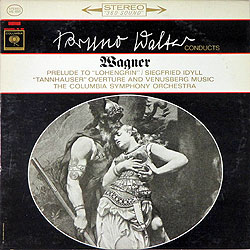
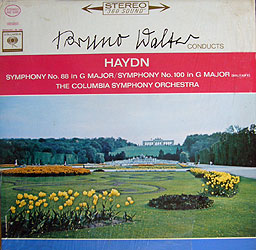 Walter recorded little Wagner between his first few slices and a final surge. Given the temperament of his last years, expectedly he did not revisit such former powerhouses as the Faust Overture, Siegfried's Rhine Journey or the Tristan Liebestod. Yet his stereo series hardly shrank from tackling potent excerpts. While the Meistersinger Prelude and Flying Dutchman Overture attenuate drama for nobility and control and the Parsifal Prelude is naturally dreamy, the Lohengrin Prelude and Tannhauser Overture begin and end in whispers but rise and fall forcefully to and from their central climaxes, and the Tannhauser Bacchanale asserts mature, eminently musical potency throughout its prolonged unshapen duration, ultimately slipping into the brief appearance of an ethereal choir, a lovely (and expensive) final touch that most recordings omit. The gem is the Siegfried-Idyll which, perhaps as a symbol of his affection, Walter recorded far more than any other work. In 1966 Columbia reissued it in a box set with his other late Wagner and a 45-minute rehearsal sequence which both displays his love of the piece as he sings along and, as producer Thomas Frost notes, shows that he not only had evolved to a high level of musical understanding but had mastered the art of human relations as well. This, his sixth (!) and final studio take, is soft, gentle and loving, tempering the climax to amplify but not detract from the tenderness of the rest, turning Wagner's saccharine family greeting into a ravishingly lovely gesture of his own embrace and farewell to life.
Walter recorded little Wagner between his first few slices and a final surge. Given the temperament of his last years, expectedly he did not revisit such former powerhouses as the Faust Overture, Siegfried's Rhine Journey or the Tristan Liebestod. Yet his stereo series hardly shrank from tackling potent excerpts. While the Meistersinger Prelude and Flying Dutchman Overture attenuate drama for nobility and control and the Parsifal Prelude is naturally dreamy, the Lohengrin Prelude and Tannhauser Overture begin and end in whispers but rise and fall forcefully to and from their central climaxes, and the Tannhauser Bacchanale asserts mature, eminently musical potency throughout its prolonged unshapen duration, ultimately slipping into the brief appearance of an ethereal choir, a lovely (and expensive) final touch that most recordings omit. The gem is the Siegfried-Idyll which, perhaps as a symbol of his affection, Walter recorded far more than any other work. In 1966 Columbia reissued it in a box set with his other late Wagner and a 45-minute rehearsal sequence which both displays his love of the piece as he sings along and, as producer Thomas Frost notes, shows that he not only had evolved to a high level of musical understanding but had mastered the art of human relations as well. This, his sixth (!) and final studio take, is soft, gentle and loving, tempering the climax to amplify but not detract from the tenderness of the rest, turning Wagner's saccharine family greeting into a ravishingly lovely gesture of his own embrace and farewell to life.
And so ended Walter's remarkable musical journey. Of all the conductors on record, only Furtw�ngler approached (but never matched) such a radical compound transformation of outlook. That one man could embrace such an astounding variety of interpretation attests to the power of music and its ineffable impact upon the human soul in ways that transcend the ephemera of our lives.
A Personal Note – It seems so very long ago (well, I suppose it was) ... The first full set of Beethoven symphonies I ever bought was Walter's Columbia Symphony LPs, individually and in mono – why pay $1 more for stereo? Even then I must have recognized and chafed against the limits of Walter's late style – I made a "mix tape" to "improve" his Beethoven Pastoral by splicing in Toscanini's potent thunderstorm – but his abiding warmth and humanity clearly resonated in my prepubescent soul. In the six decades since, I've managed to hear and ponder nearly all of Walter's studio recordings and most of his recorded concerts, albeit rather randomly as I happened to come across them. I recognize that this article is apt to hold little outside interest, but it already has served a deeply meaningful if private purpose by prodding me to organize my thoughts on the depth, range and evolution of Walter's art on which I've reflected ever since being spellbound by those first Beethoven albums a thousand years ago.
I gratefully acknowledge the following sources for the facts and quotations contained in this article, and to which I refer you for further information. I'll take credit and blame for the opinions and comments. (Full disclosure: I confess that I blatantly cribbed some passages about recordings by Walter and others from my classicalnotes articles about the specific pieces; I won't sue myself.) Also generally listed are the sources for the recordings upon which I relied.
- Biographies:
- Ryding, Erik and Rebecca Pechefsky: Bruno Walter – A World Elsewhere (Yale, 2001) – Remarkably, this is the only full-length biography of such an important artist, and focused on Walter's life and concerts rather than on his recordings.
- Kluge, Andreas: notes to various volumes of Bruno Walter – The Edition (Sony CDs, 1995-6) – occasionally useful supplements to the Ryding/Pechefsky book, each one focusing on an individual topic.
- Books by Walter:
- Theme and Variations (tr.: James A. Galston; Knopf, 1948) – an autobiography written mid-way during his New York Philharmonic years, with personal views of history, colleagues and his career up to that point, but barely a word about his recordings.
- Of Music and Music-Making (tr.: Paul Hamburger; Norton, 1957/1961) – intended as a finale to his Theme and Variations, but rather than updating that volume Walter reflects on the origins of music, the training and role of the conductor, and various aspects of music-making (e.g., tempo, rhythm, clarity, expression).
- Discographies and Databases:
- Altena, James, Steven Reveyoso and Erik Ryding: Recorded Performances of Bruno Walter (1876-1962) – although last updated in 2010, this still seems to be a thorough listing of all known Walter recordings and their history of publication, including live performances (many frustratingly sourced only as being in a "private collection"); generously made available on the web.
- Marsh, Robert C.: A Discography – The Heritage of Bruno Walter (High Fidelity, January 1964) – Although I often tend to disagree with his opinions, Marsh annotates his listing of Walter's commercial recordings with brief evaluations that tend to give short shrift to the earlier ones; posted here by David Gleason on his awesome American Radio History website which features nearly complete runs of vast numbers of broadcasting, engineering and related magazines.
- Centre for the History and Analysis of Recorded Music (CHARM) – a searchable online database of recordings, largely compiling others' research.
- Metropolitan Opera Archives – a database with contemporaneous reviews of many Walter Met performances, including all those quoted here for Fidelio and Don Giovanni.
- Other Written Sources:
- Blythe, Alan: notes to Wagner: Die Walk�re, Act I (EMI Great Recordings of the Century CD, CDH 7102 02, 1988)
- Chesterman, Robert: Conversations With Conductors (Robson Books, 1976)
- Duggan, Tony: "The Mahler Symphonies – A Synoptic Survey" (MusicWeb International, 2006)
- Ewen, David: Dictators of the Baton (Ziff-Davis, 1948)
- Frank, Mortimer: Arturo Toscanini – The NBC Years (Amadeus Press, 2002)
- Frost, Thomas: "Recording With Bruno Walter: Memoirs of a Producer," notes to Bruno Walter – The Edition: Wagner Orchestral Music (Sony CD SM2K 64456, 1994)
- McClure, John T.: "An Education and a Joy" (High Fidelity, January 1964)
- Michaelis, Arnold: Interview of Bruno Walter on the Eve of His 80th Birthday (Columbia LP BW-80, 1956)
- Quinn, John: review of the Andante CD issue of Walter's 1942 Met Figaro (MusicWeb International)
- Quonten, Ren�: notes to Bruno Walter, Volume 1: His First US Records of Beethoven 1941-1942 (Lys CDs LYS 308-309, 1998)
- Riemens, Leo: Wagner: notes to Wagner: Die Walk�re, Act I (Great Recordings of the Century LP, Angel COLH 133, 1962)
- Schoenberg, Harold: The Great Conductors (Simon & Schuster, 1967)
- Scott, Michael: The Record of Singing, Volume 2 (Gerald Duckworth & Co., 1979)
- Tubeuf, Andr�: notes to the Walter/Vienna Philharmonic LP of the Mahler Ninth (EMI R�f�rences 2 C 151 53824/5)
- "T.W.G.": "Walter, Bruno (B. W. Schlesinger)," article in Grove's Dictionary of Music and Musicians, Fifth Edition (ed.: Eric Blom, St. Martin's Press, 1954)
- Wechsberg, Joseph: "Bruno Walter: Mission Accomplished," notes to the Walter/Columbia Symphony LP of the Mahler Ninth (Columbia M2S-676, 1962)
- And, most important of all, the recordings themselves (many are posted on YouTube in transfers of variable quality):
- Acousticals – Pristine Audio downloads
- Pre-War Electricals – Lys CDs + some EMI Great Recordings of the Century LPs and CDs
- Farewell to Vienna – EMI R�f�rences LPs + VAI, Music & Arts and AS Disc CDs
- The NBC Concerts – private collections (the confidentiality of which I will respect, out of concern with liability under our absurd US copyright laws)
- The Met – Arkadia CDs + private collections (same concern here)
- The New York Philharmonic Years – original LPs + some Lys and Sony Bruno Walter Edition CDs
- The Stereo Recordings – original LPs + some Sony Bruno Walter Edition CDs.
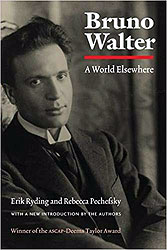
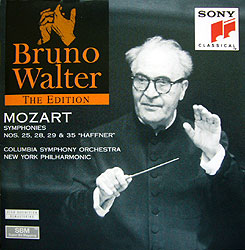
Copyright 2019 by Peter Gutmann
copyright © 1998–2019 by Peter Gutmann. All rights reserved.